This post is written by Jet Toyco, a trader and trading coach.
Welcome to the ultimate showdown between limit order vs stop order strategies!
If you’re new to trading…
You may be wondering what these terms mean
But if you’re already trading…
Then you may be looking for ways to improve your profitability.
That’s why in this comprehensive guide…
- We will explore the differences between these two orders
- The common mistakes traders make when placing them
- The secret to using them both is to maximize your trading profits.
- An in-depth answer to which one you should use
Sounds good?
Then let’s get started!
Limit order vs stop order: What are they and how do they work?
Now…
Limit orders and stop orders are two of the most commonly used order types in trading.
But what do they even mean?
And how do they work?
Well, let me break it down for you.
First…
Limit order
Imagine this…
You’re overworked at home.
Stressed, probably from all those trading losses.
You look at your clock and you realized it’s already close to 12 AM!
You didn’t have dinner yet!
So, what do you do?
In this day and age, you have two options:
- Get your ass up, go out, and order at the nearest restaurant
- Have somebody else deliver it for you
Which one will you pick?
The first one, of course!
In this case…
You don’t have to work too hard to get your food.
The food comes to you!
And this is the same for a limit order in trading!
You see that the price is way too damn high:
But as a wise trader, you tell yourself:
“Ain’t no way I’m buying at this current price!”
“It’s too damn high!”
So, what do you do?
You wait for the price to come at an area of value by placing a limit order:
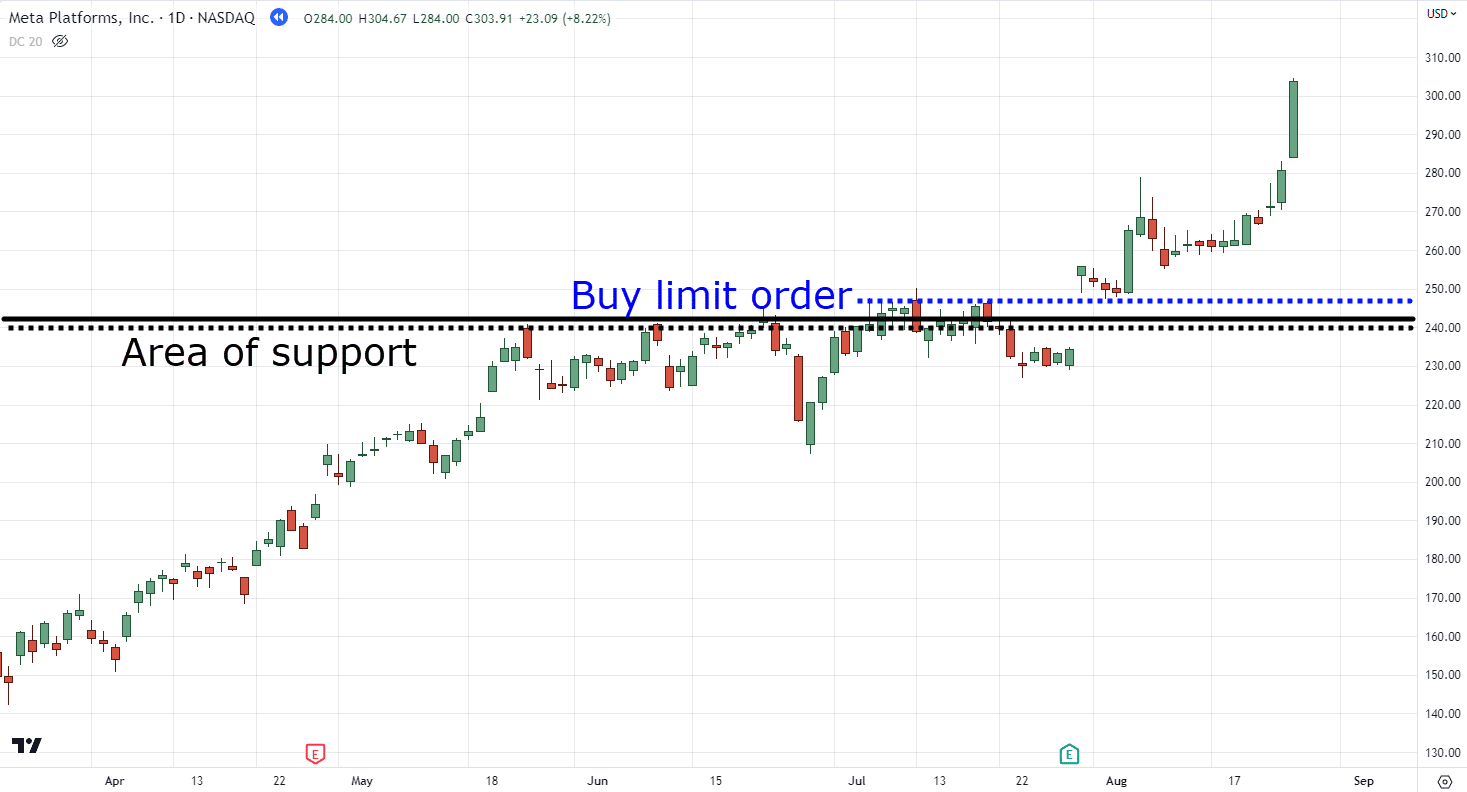
You want the price to go down so that you’ll be in a more favorable trade!
So, just like your food, you wait:
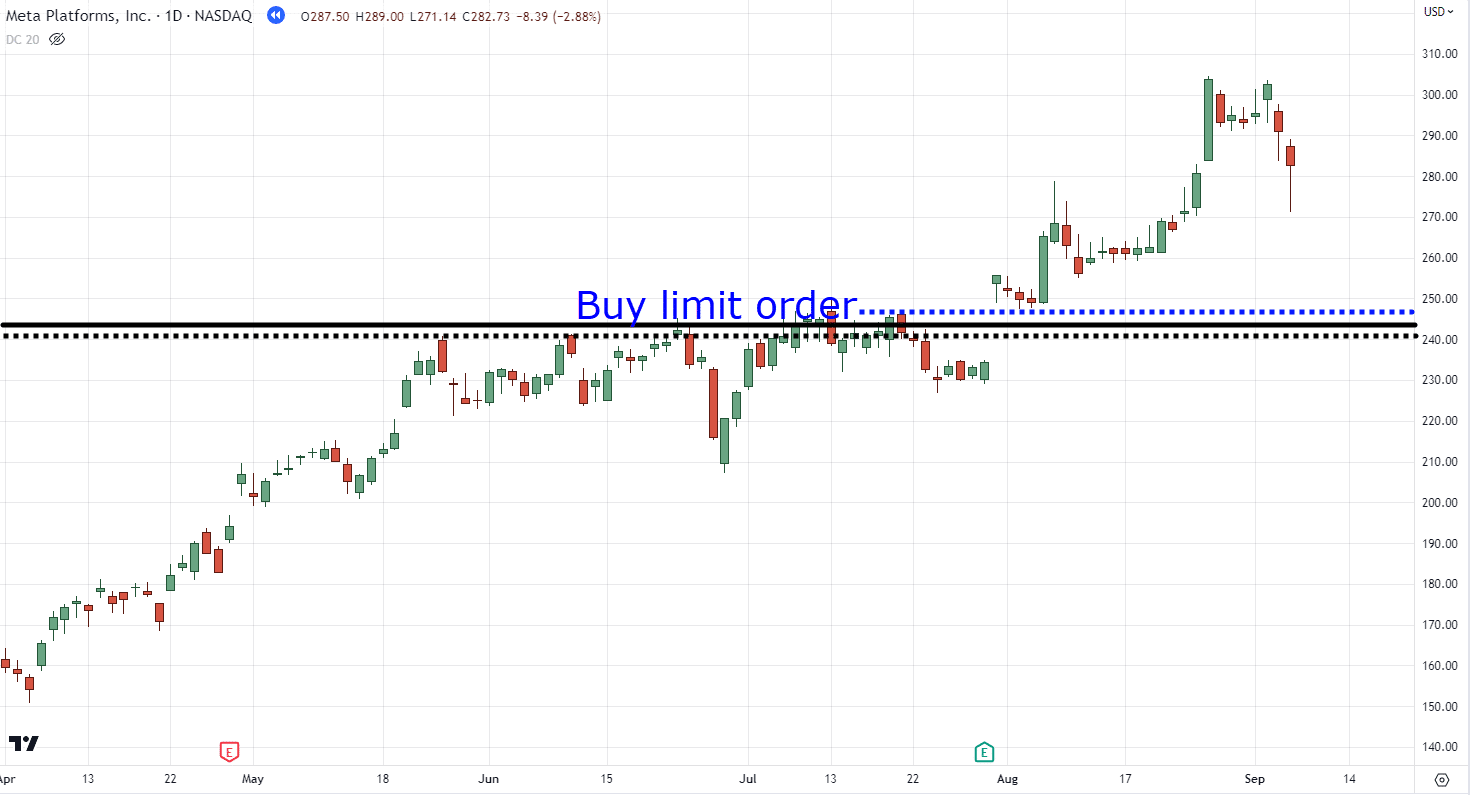
You wait:
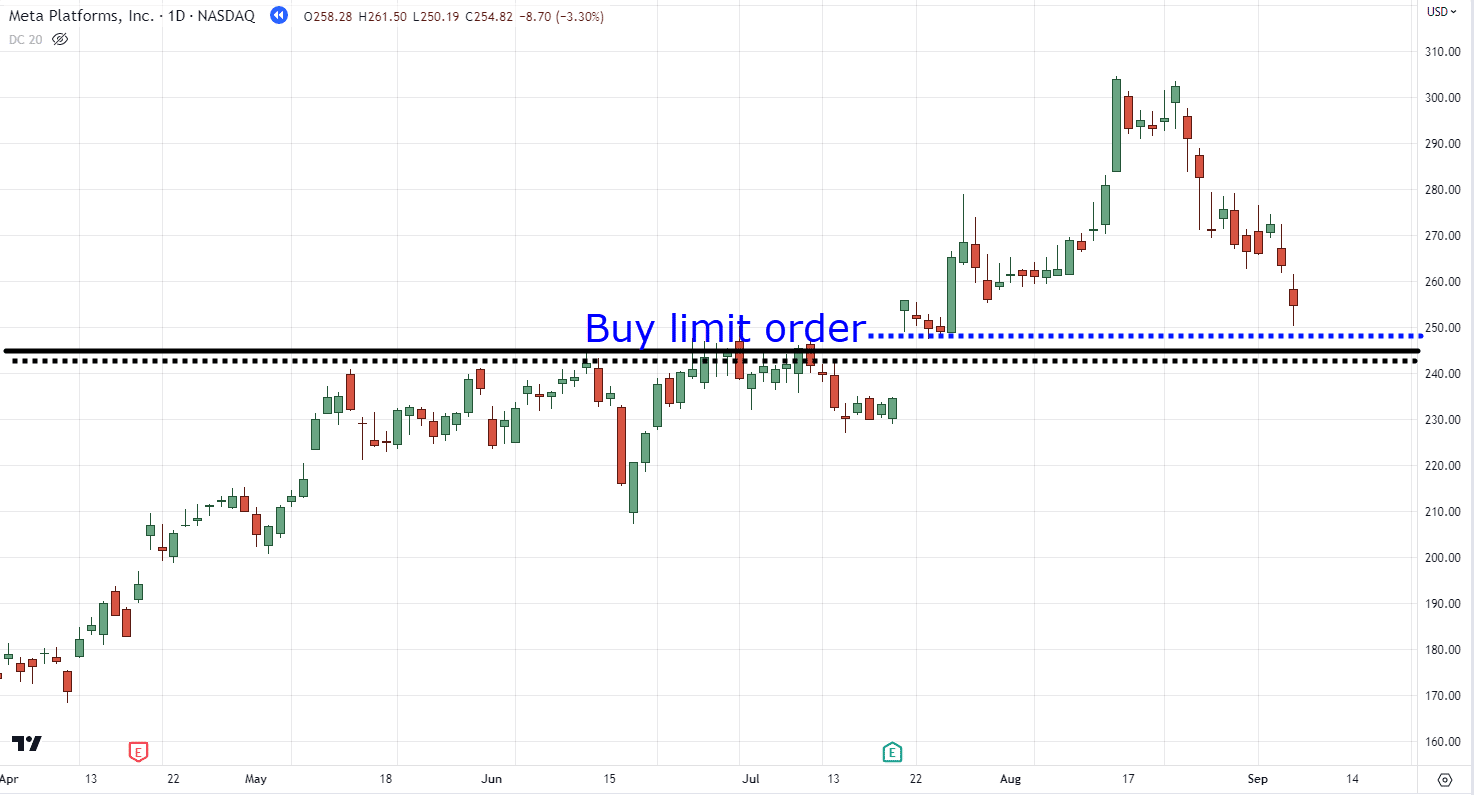
And then you wait:
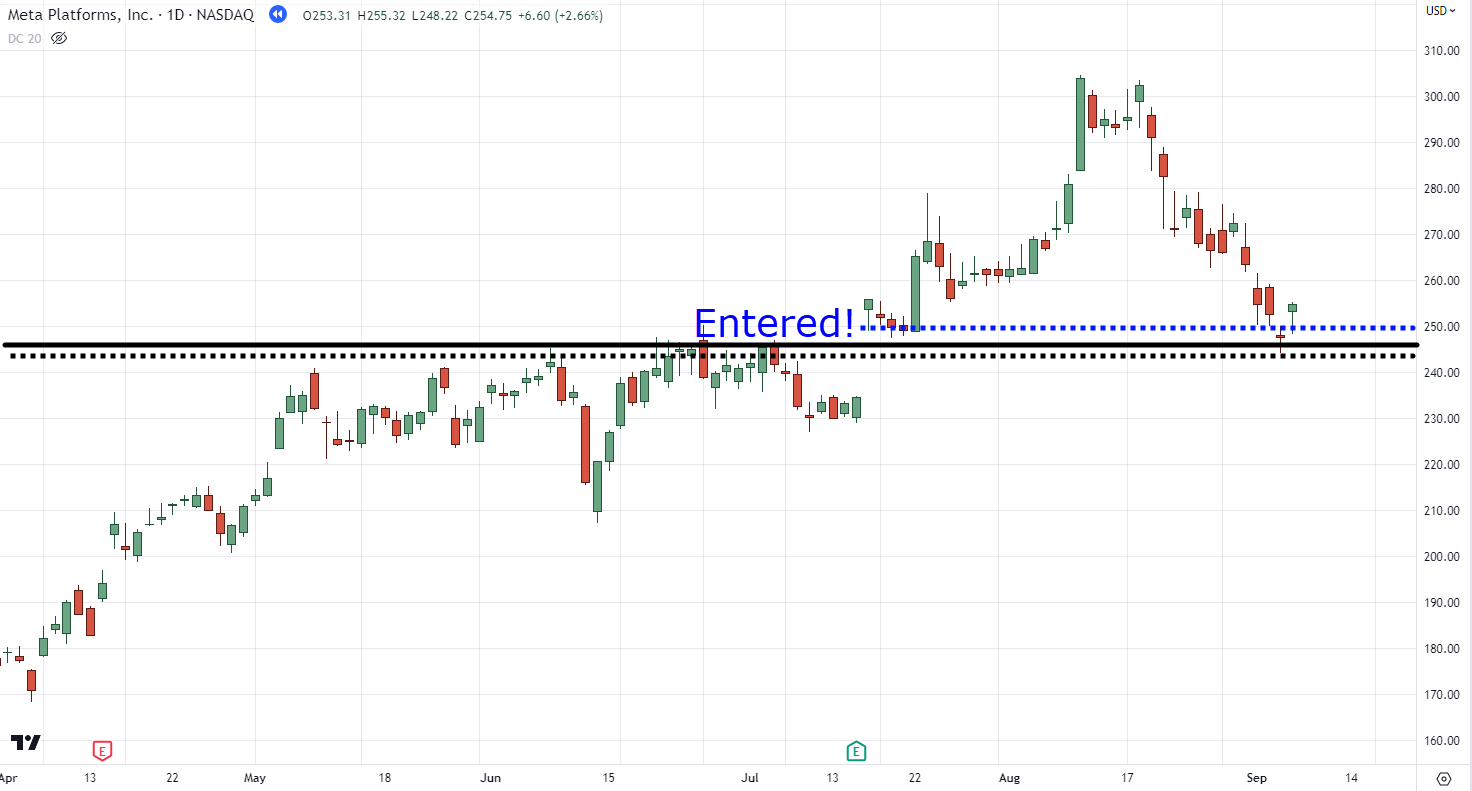
Once your food arrives at the area of support, boom!
Not only are you in the trade, but you’re in a trade that’s worth your juicy time!
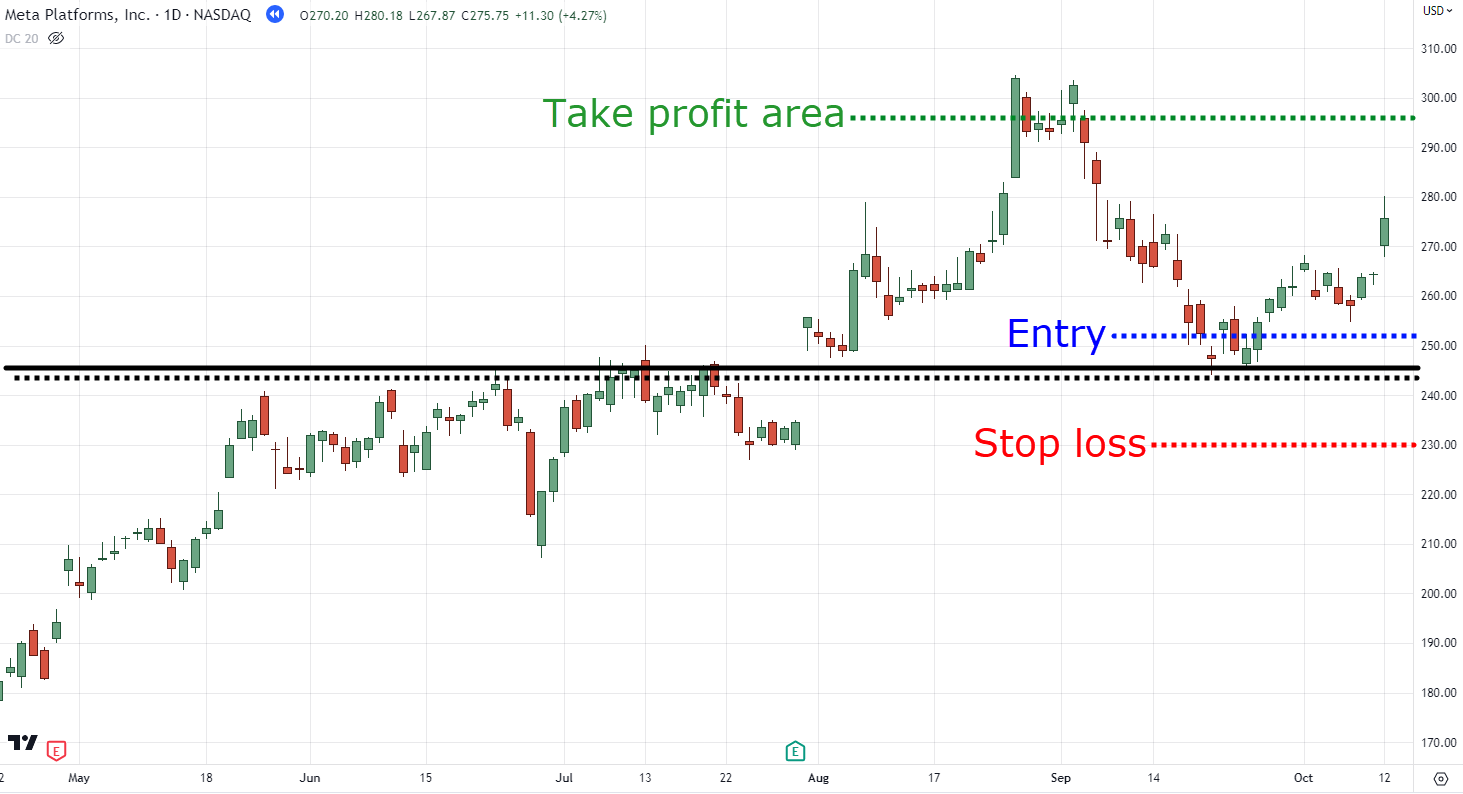
See what I mean?
Placing a limit order means that you’re placing an order below the market price so that you can hop in at a better price (it’s just the opposite for shorting).
Makes sense?
Now what about a stop order?
Stop order
A stop order is like trying exotic food.

Many people can be hesitant to be the first ones to try it!
YOU might be hesitant to try it out first!
So, what do you do?
You ask your family members to taste it first!
You need confirmation to see if it’s good and safe to eat!
Once it’s safe and good to eat then the more you’d have the confidence to try it out.

Yum!
Similarly…
A stop order in trading is like waiting for someone else to try the exotic food first!
You need extra confirmation!
Sure, you see a nice trend currently on a pullback.
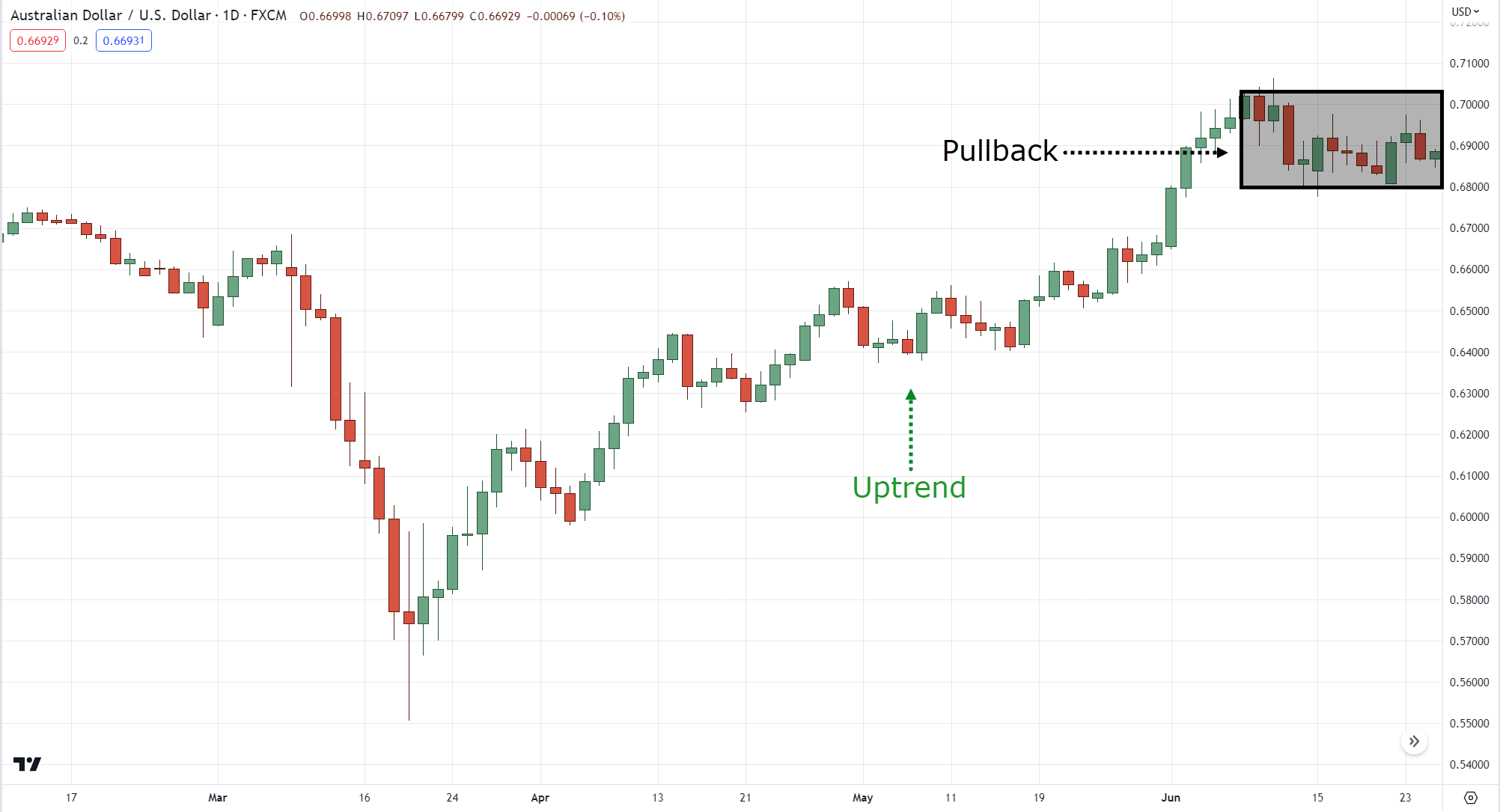
But then you ask yourself:
“Hmm how sure am I that the trend will continue”
“Is this a pullback? Or a complete reversal?”
In this case, what do you do?
That’s right.
You place a stop order above the breakout point:
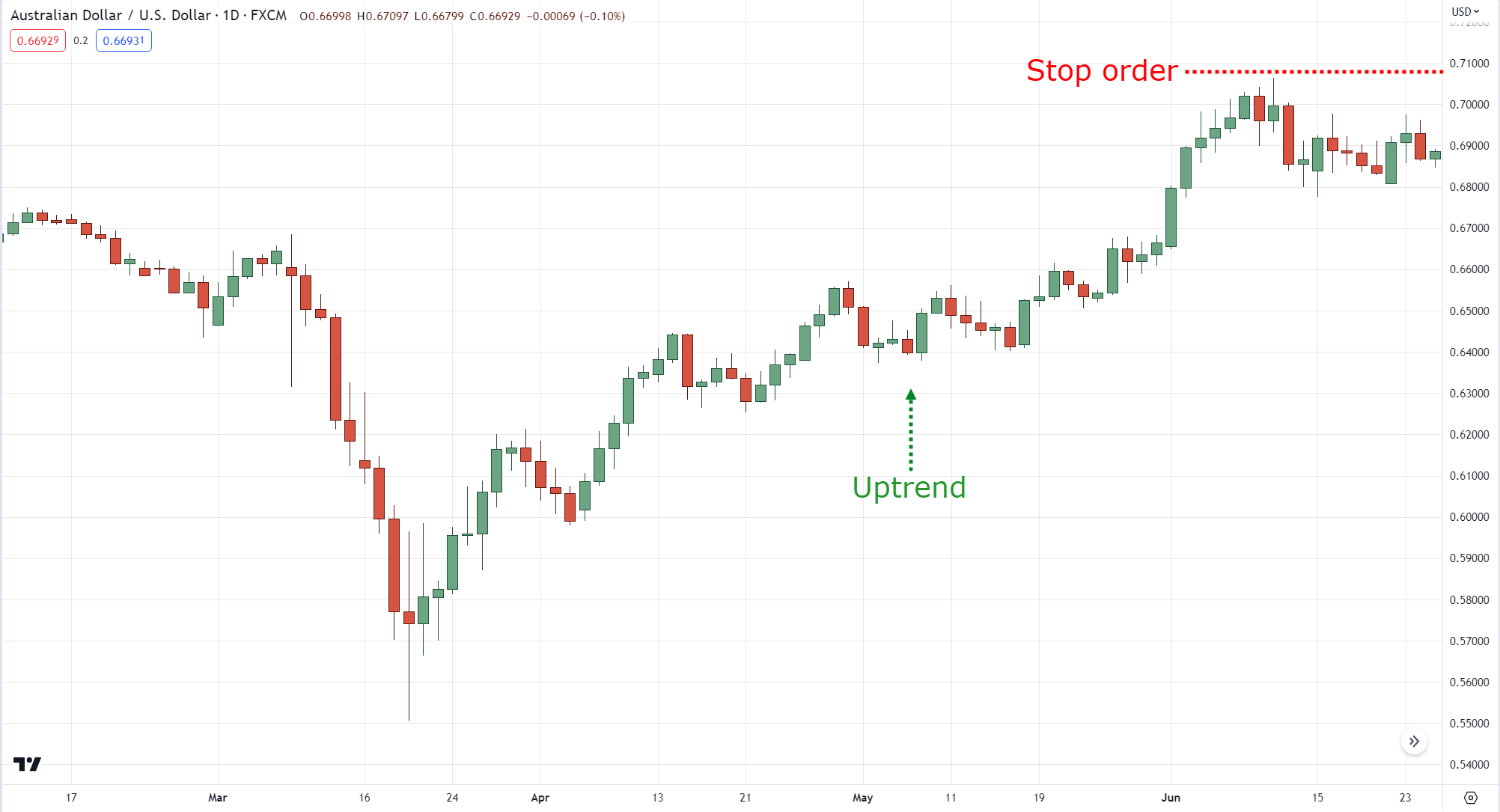
This means that before you even enter the trade, you want the market to commit to you by breaking out first!
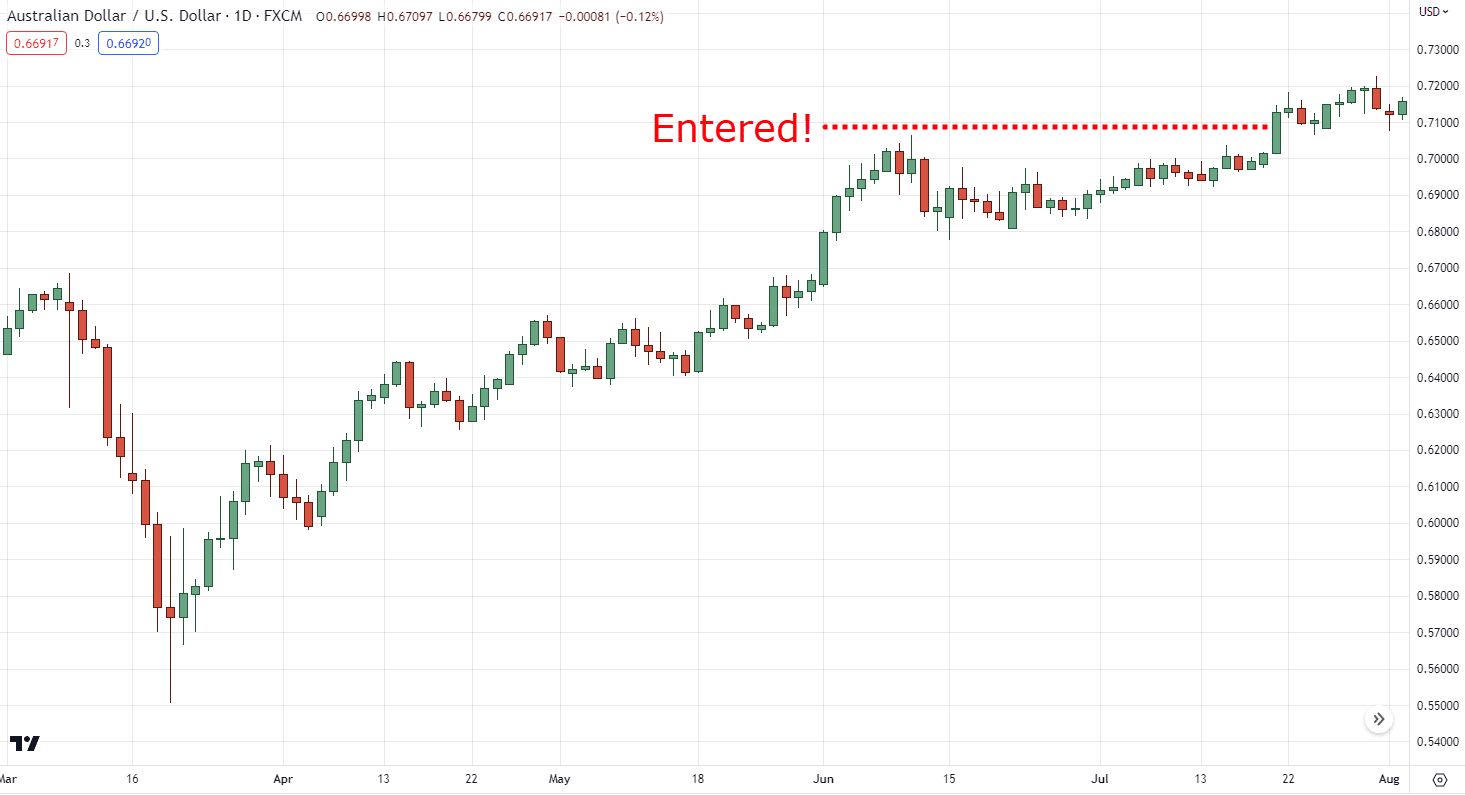
Makes sense?
But the bottom line is this…
Placing a limit order means that you want the price to come down to you so that you can enter at a better price.
A stop order on the other hand is when you want the price to increase to a certain point before you enter.
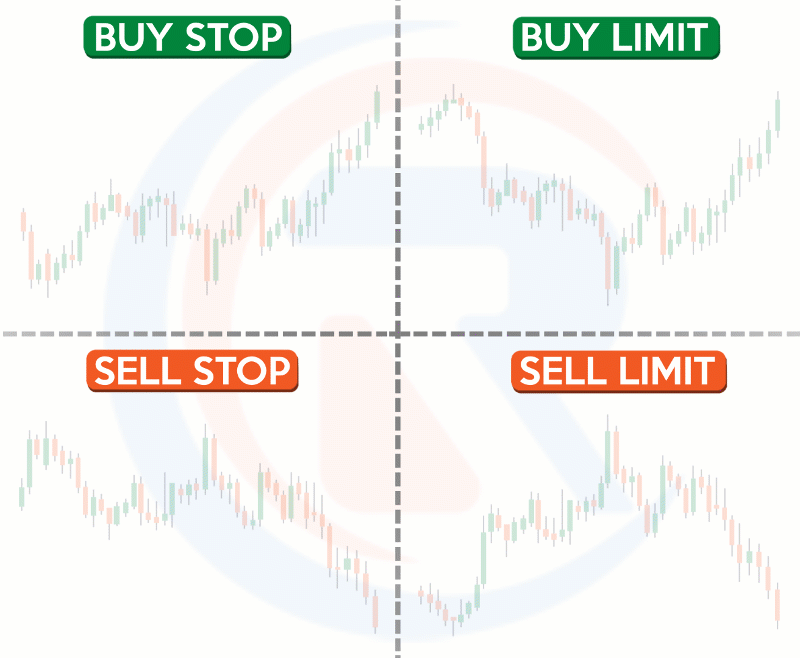
Got it?
Now that you know the ins and outs of the limit order and stop order…
It’s equally important for you to know how NOT to use them!
As this mistake costs me a lot during my early days in trading.
Want to know what that is?
Then let’s move on to the next section!
Limit order vs stop order: Huge MISTAKES traders make when placing these orders
So, you’ve learned about limit orders and stop orders.
Now, let’s talk about the biggest mistakes traders make when using these orders.
It’s like a freaking deadly sin to commit in trading!
One of them?
Is to…
1. Never place a limit order above the current price or a stop order below the current price.
I’m telling you.
This is a newbie mistake you must avoid!
Remember what I showed you before?

That’s right, you better save it.
Because the moment you place a limit order above the price…
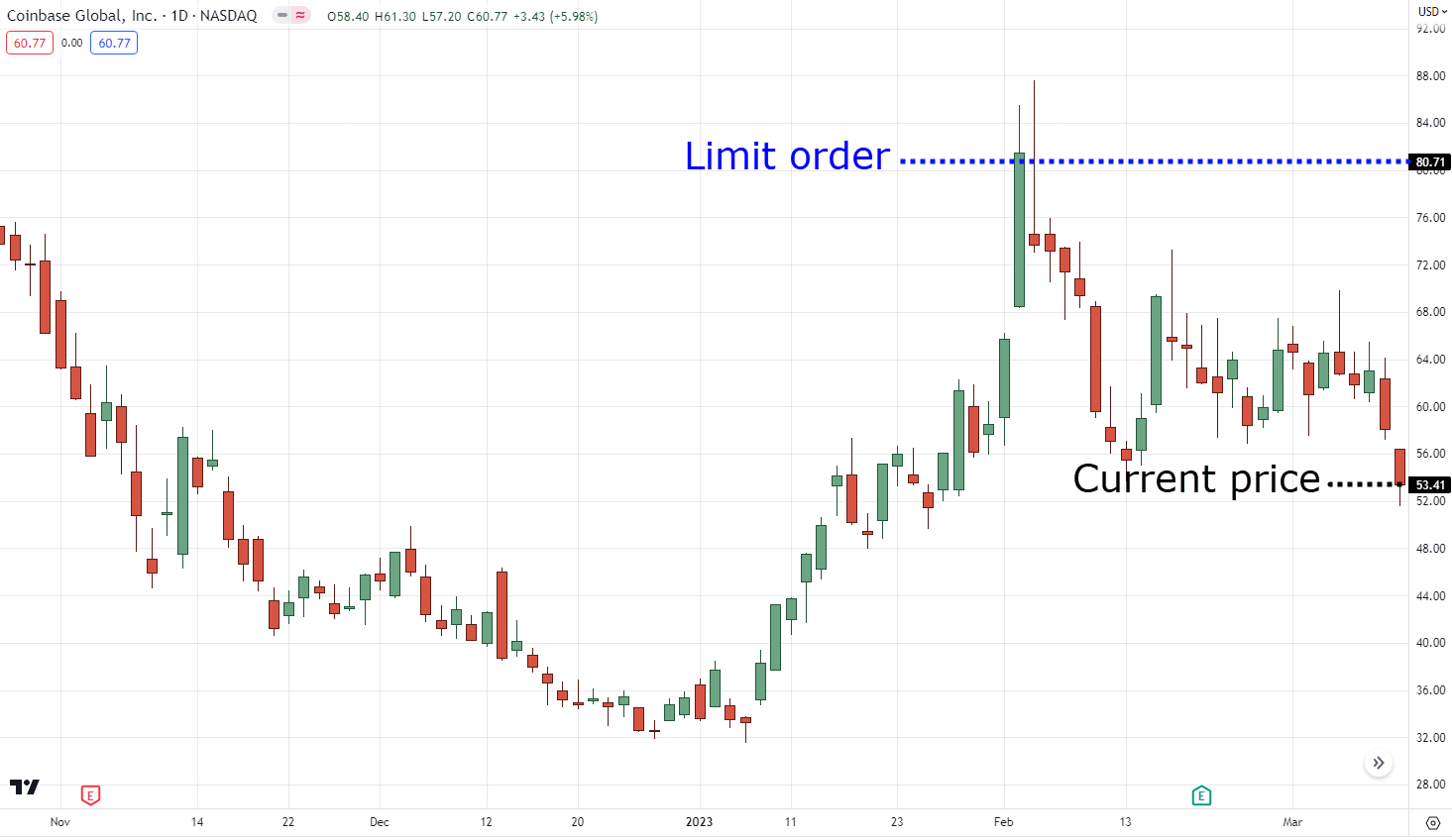
You might as well kiss your profits goodbye because you’ll be starting in the red!
Because what would happen is that your limit order would automatically be triggered at 80.71 while the current price is at 53.41
That means you’d instantly get a -30% loss!
It’s like you’re trying to dunk at the basketball net with your limit order only to fall back down to the ground!
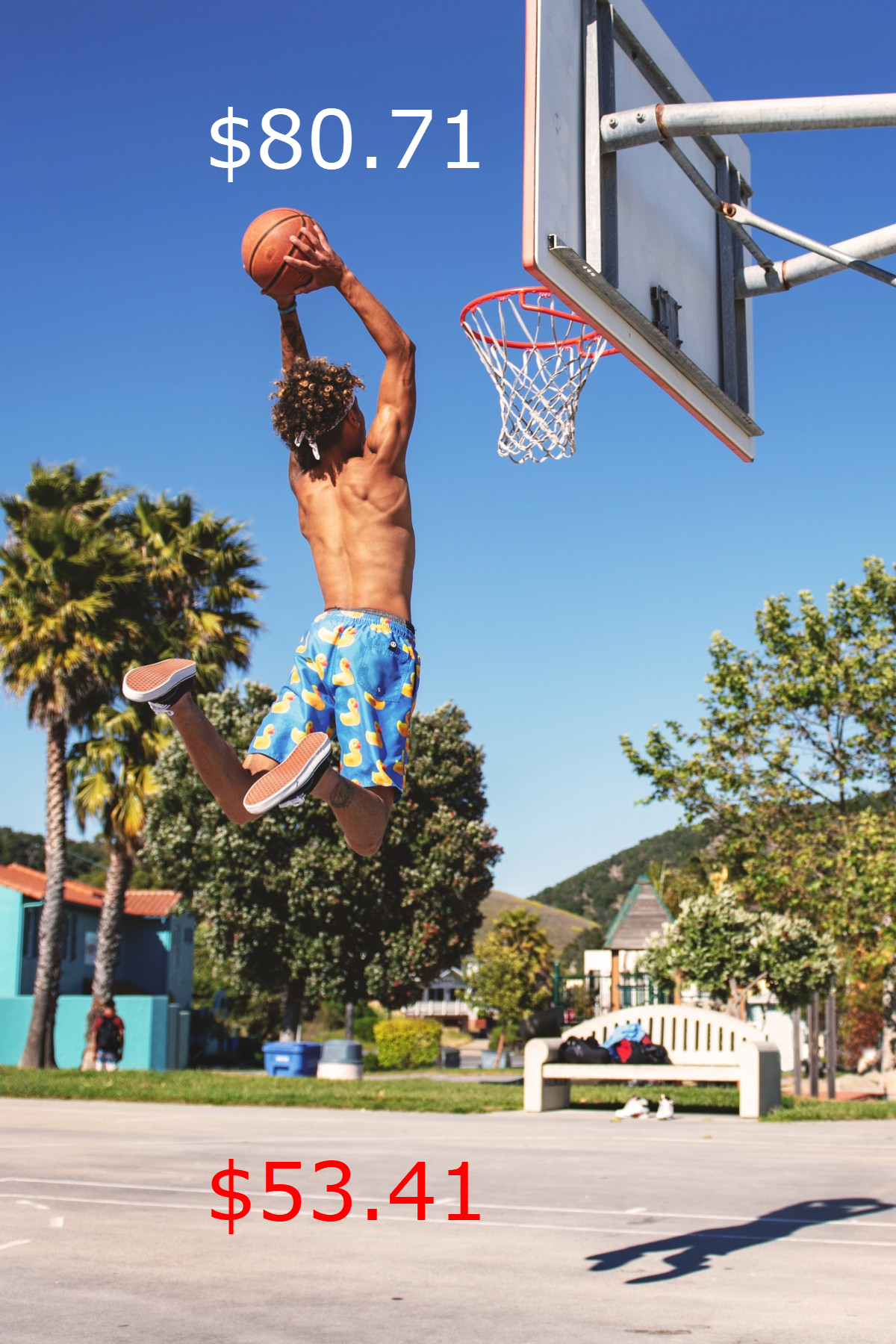
It’s like you are trying to manipulate the markets to lose money!
Got it?
So, be absolutely sure that if you’re placing a limit order…
You place it below the current price:
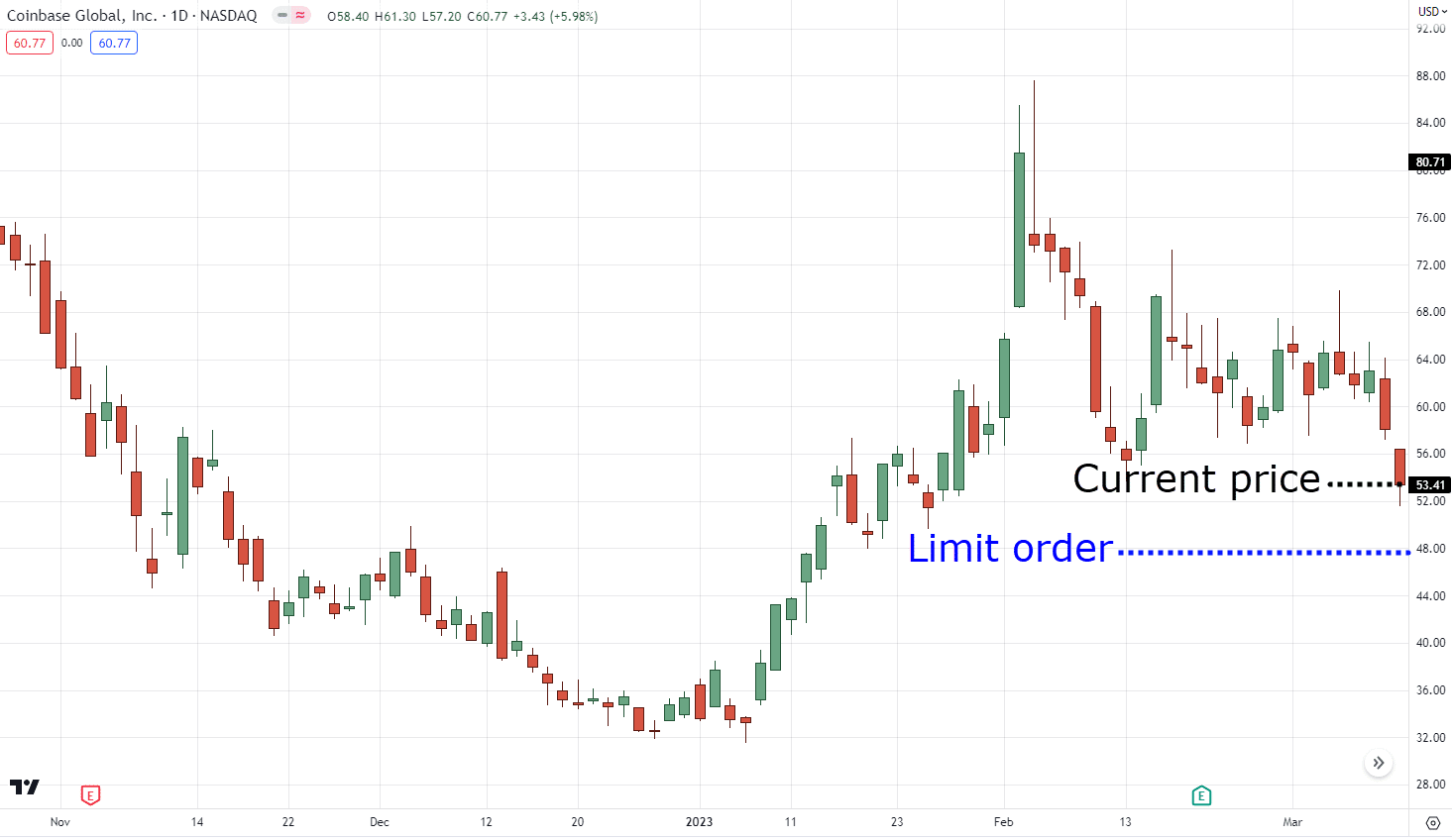
If you’re placing a stop order…
You place it above the current price:
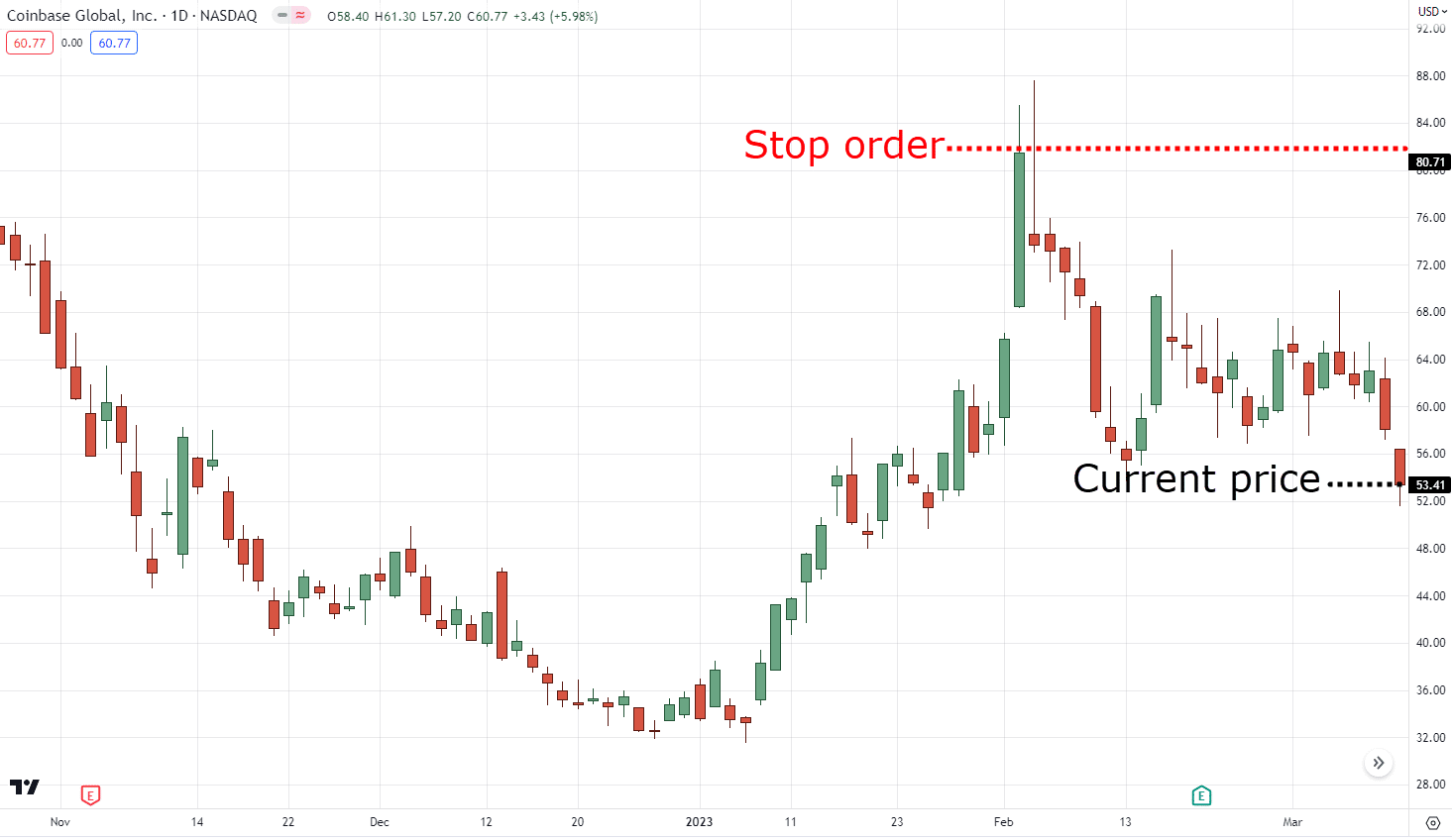
Not a limit order, alright?
And it’s just the opposite for shorts.
Secondly…
2. Always place the orders at an area of value
No matter what you do.
Always place your orders for a reason!
Which is why I’m giving you two, that’s right.
Only two rules!
- If you’re using a limit order, always place it in the area of support.
- If you’re using a stop order, place it during a breakout.
These rules will help you enter the market at a good price and increase your chances of success.
Let me briefly explain…
If you’re using a limit order, always place it in the area of support.
Why we do this is simple.
Support & resistances are levels on your chart where price has been respected in the past and can potentially reverse in the future:
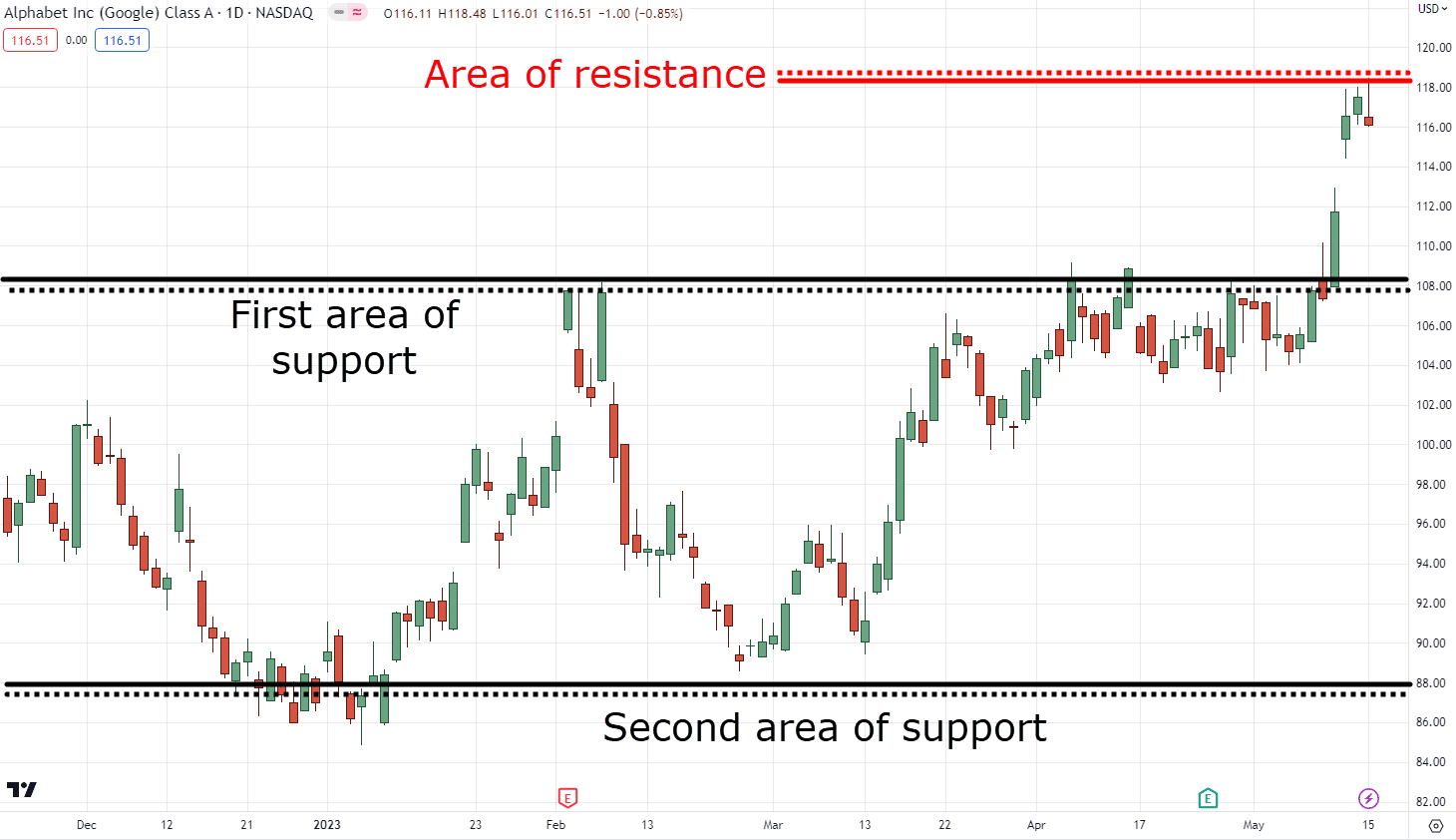
Do you know what this means?
That’s right.
Those areas are the juiciest levels to trade on!
Those levels are where the commotion happens!
This is why you are placing a limit order not only when and where you feel like it, but where the price is likely to react!
Here’s an example:
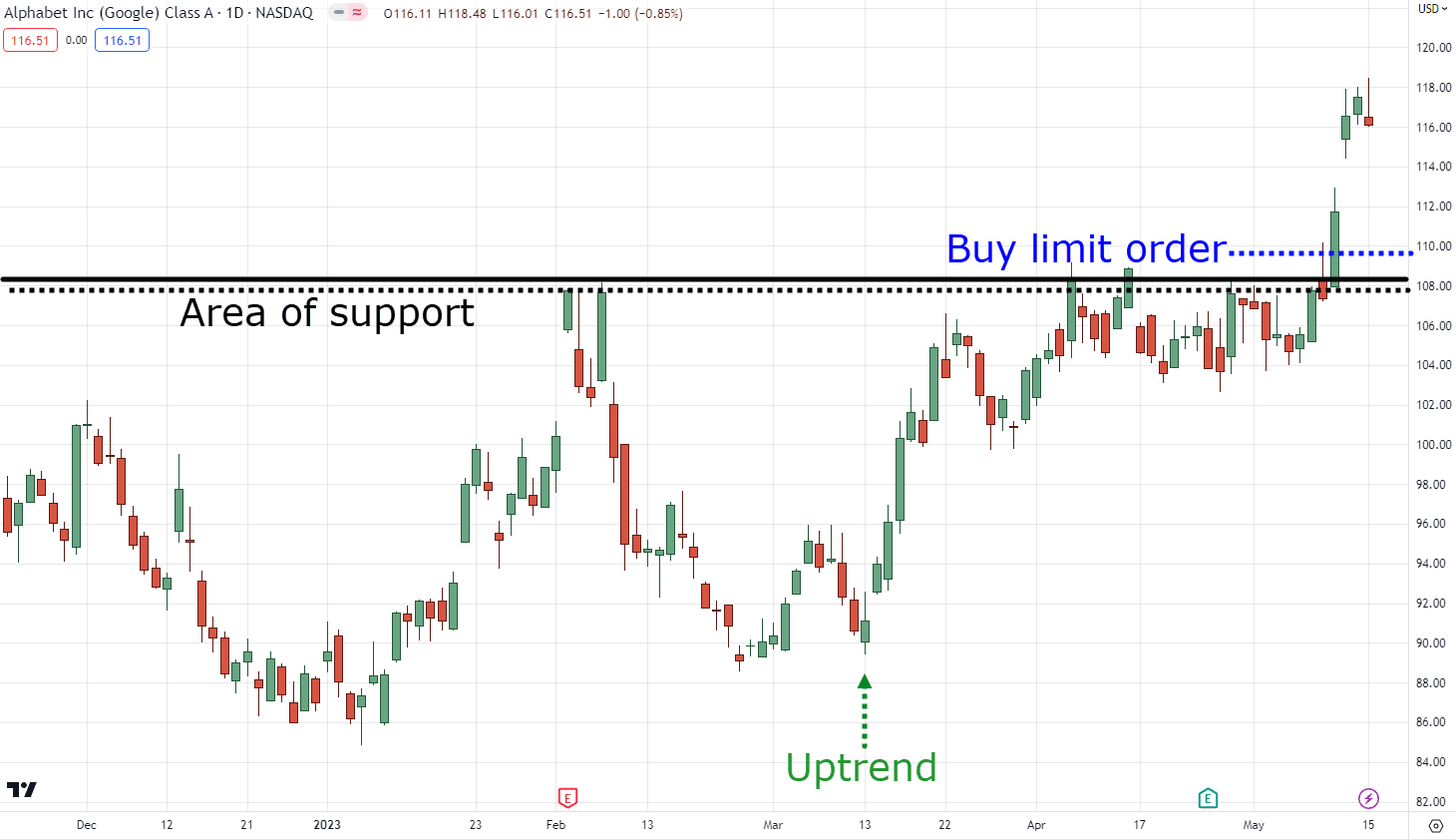
As you can see, GOOGL is in an uptrend.
This means that the juiciest level to trade on is the nearest area of support (area of resistance if the stock is in a downtrend and you’re looking to short)
So you place your limit order right at that level!
On the other hand…
If you’re using a stop order, place it during a breakout.
Recall, you want the price to commit to you first before you place the trade!
So, if you’re that kind of trader who needs that “extra” assurance but at the same time doesn’t want to closely monitor breakouts…
Then placing a stop order above the breakout point is something you must do!
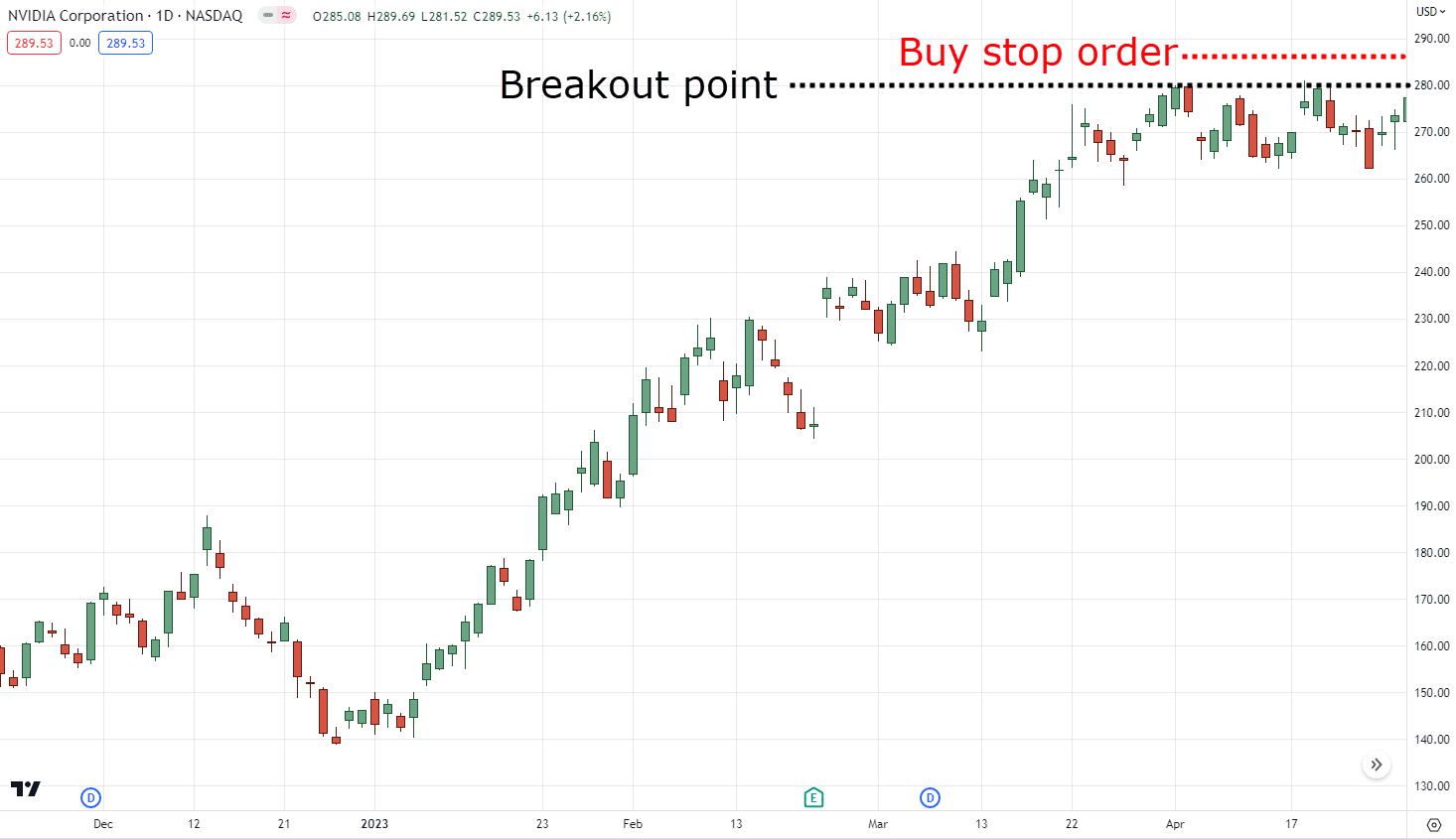
Remember that in the end…
Both of these orders are there to help you automate your trading process, which is highly required if you’re someone with a full-time job!
So…
By avoiding common mistakes such as:
- Making sure you’re placing a limit order below the price and stop order above the price
- Making sure you’re placing your orders for a reason (not just at random prices)
You’ll be one step closer to consistent profitability!
Alright!
Now that you know how the two orders work and how you should and shouldn’t use them…
What if I told you that you can use them both?
What if I told you that you can take both the blue and the red pill?
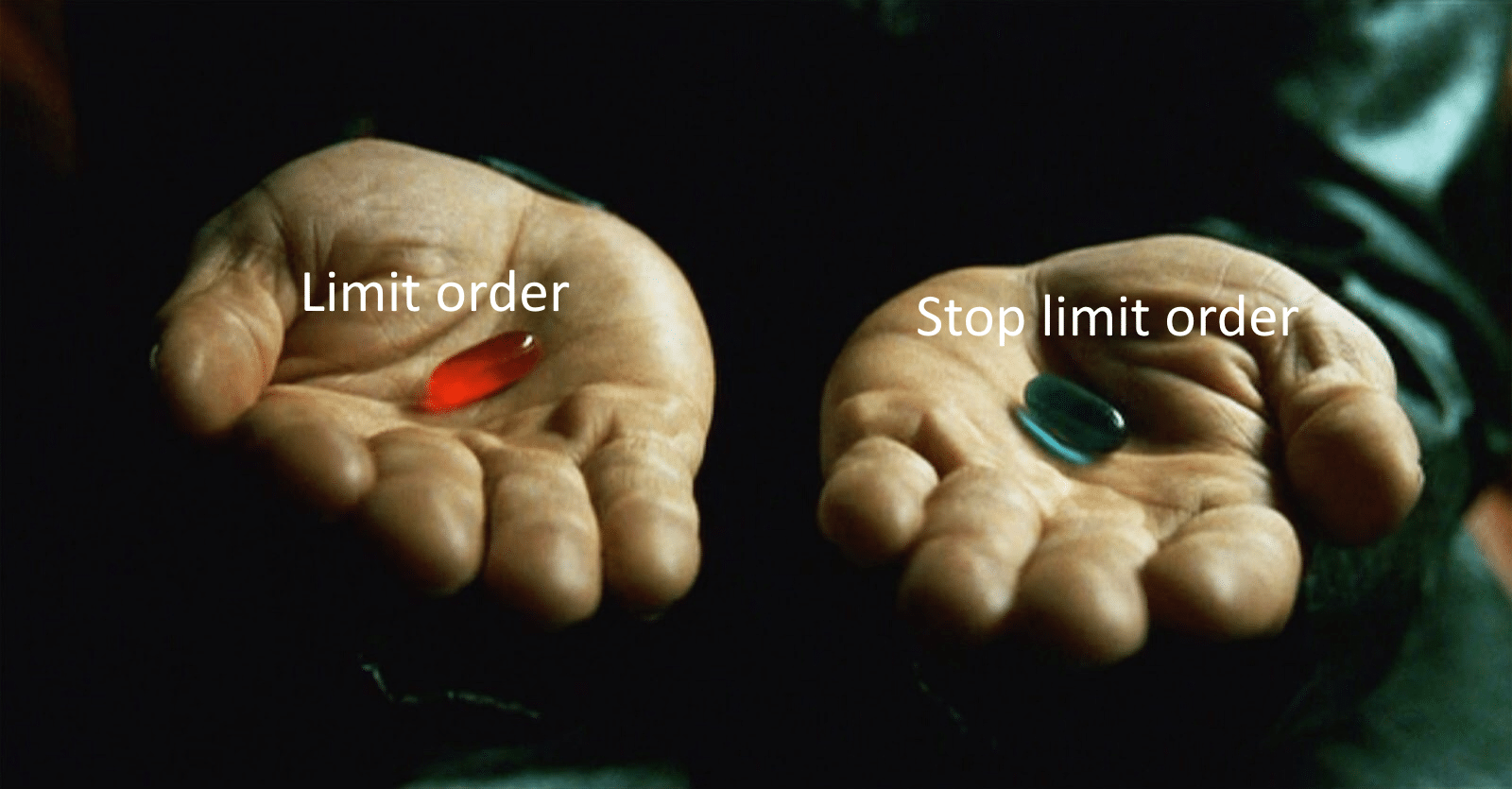
Let me show you how in the next section…
Limit order vs stop order: The SECRET to using both orders
Alright, my friend…
It’s time to unveil the secret to using both orders.
So buckle up and get ready to become a master of the markets with these three simple steps!
Step 1: Identify the market condition
First things first…
You need to identify the market condition.
Is it a downtrend?
Uptrend?
Range?
Understanding the market condition is crucial in placing the appropriate order.
So, I’ll give you a couple of examples for today.
But in this example, we’ll use Brent Crude Oil on the daily timeframe:
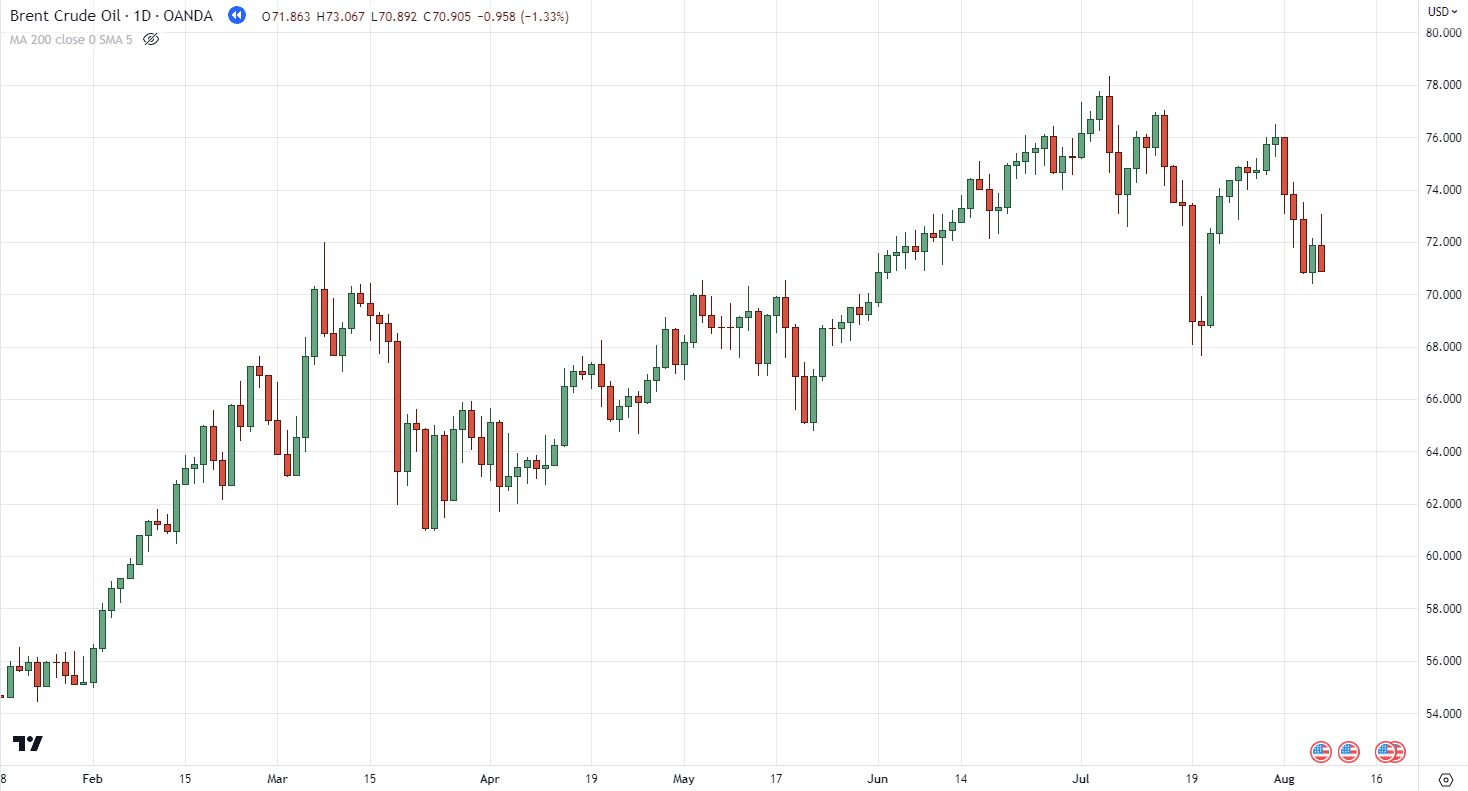
Now, without batting an eye…
This stock is obviously in a long-term uptrend!
But if you want to be as objective as possible…
You can use the 200-day moving average to objectively define whether a market is in an uptrend or downtrend.
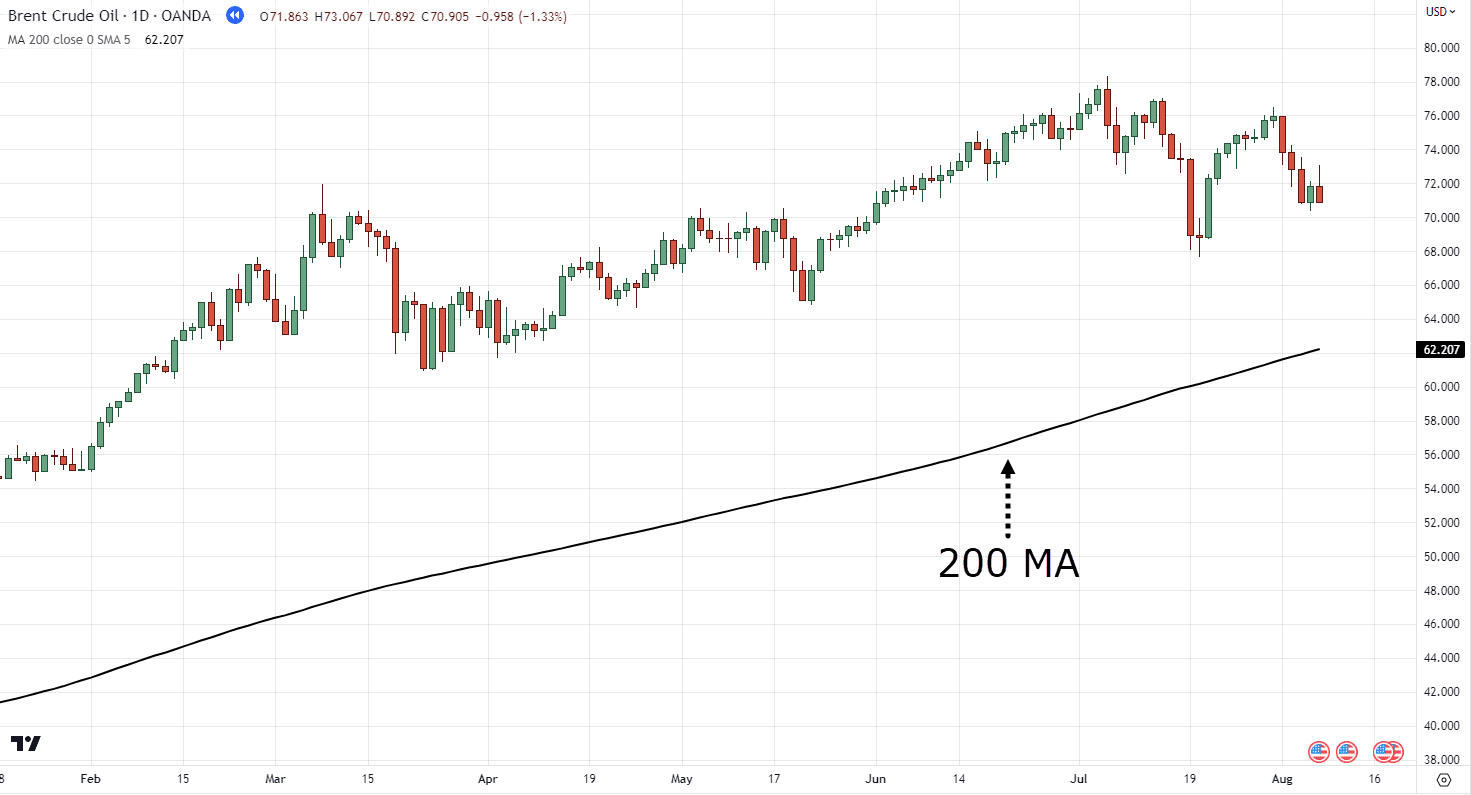
Let’s move on to step 2, shall we?
Step 2: Identify the area of value and place the appropriate orders
Once you have identified the market condition…
The next step is to identify the area of value and place the appropriate orders.
Remember…
I told you to use limit orders at areas of value and stop orders during the breakout, right?
Good.
Because for this tip, you’ll be using both.
So, how?
First, you’ll need to find a ranging market (or a long pullback) within a long-term trend.
Here’s what I mean:
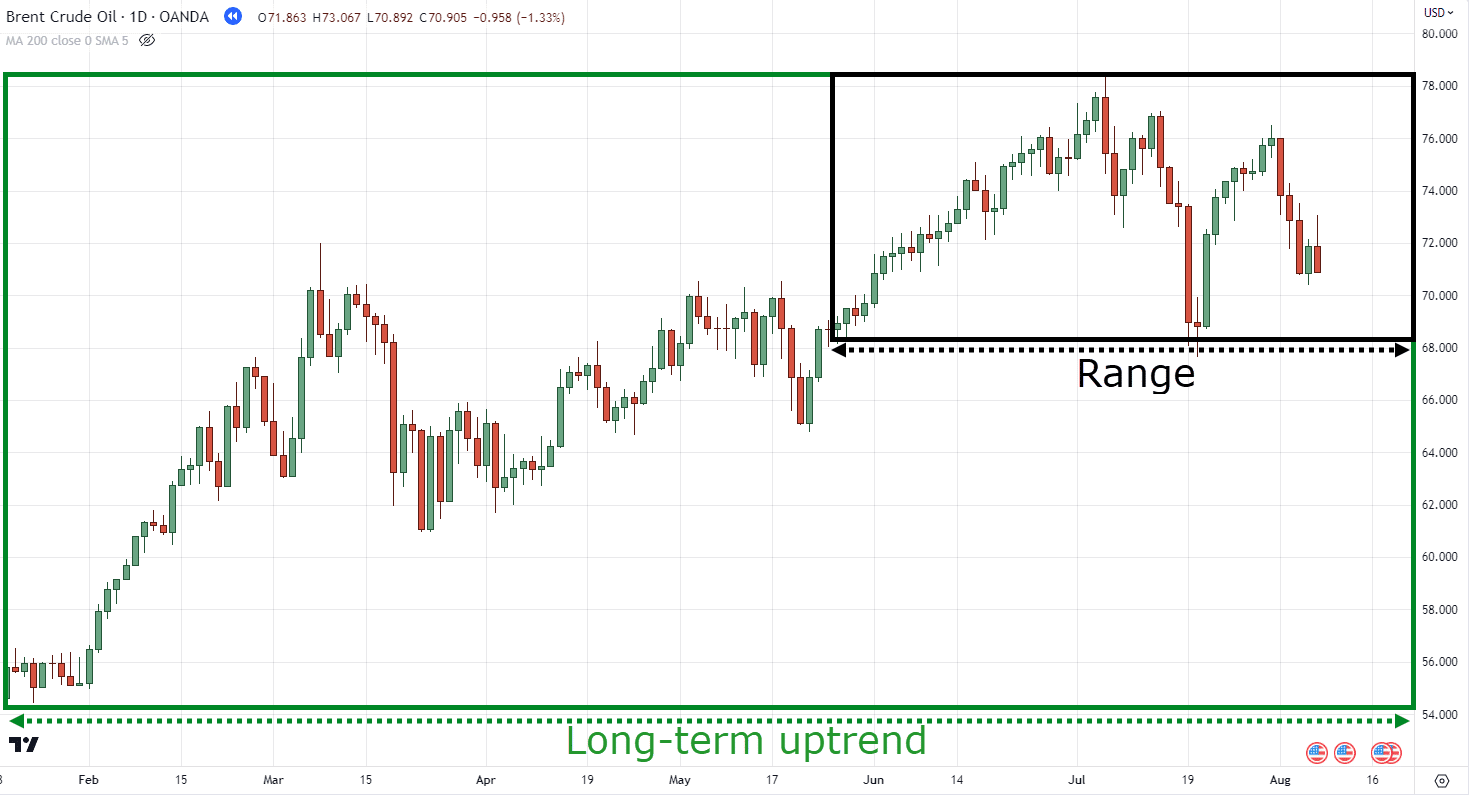
Following so far?
Awesome.
Because once you’ve found a range on top of a long-term uptrend such as the example…
The next thing that you should do is to identify your support & resistance levels—your areas of value!
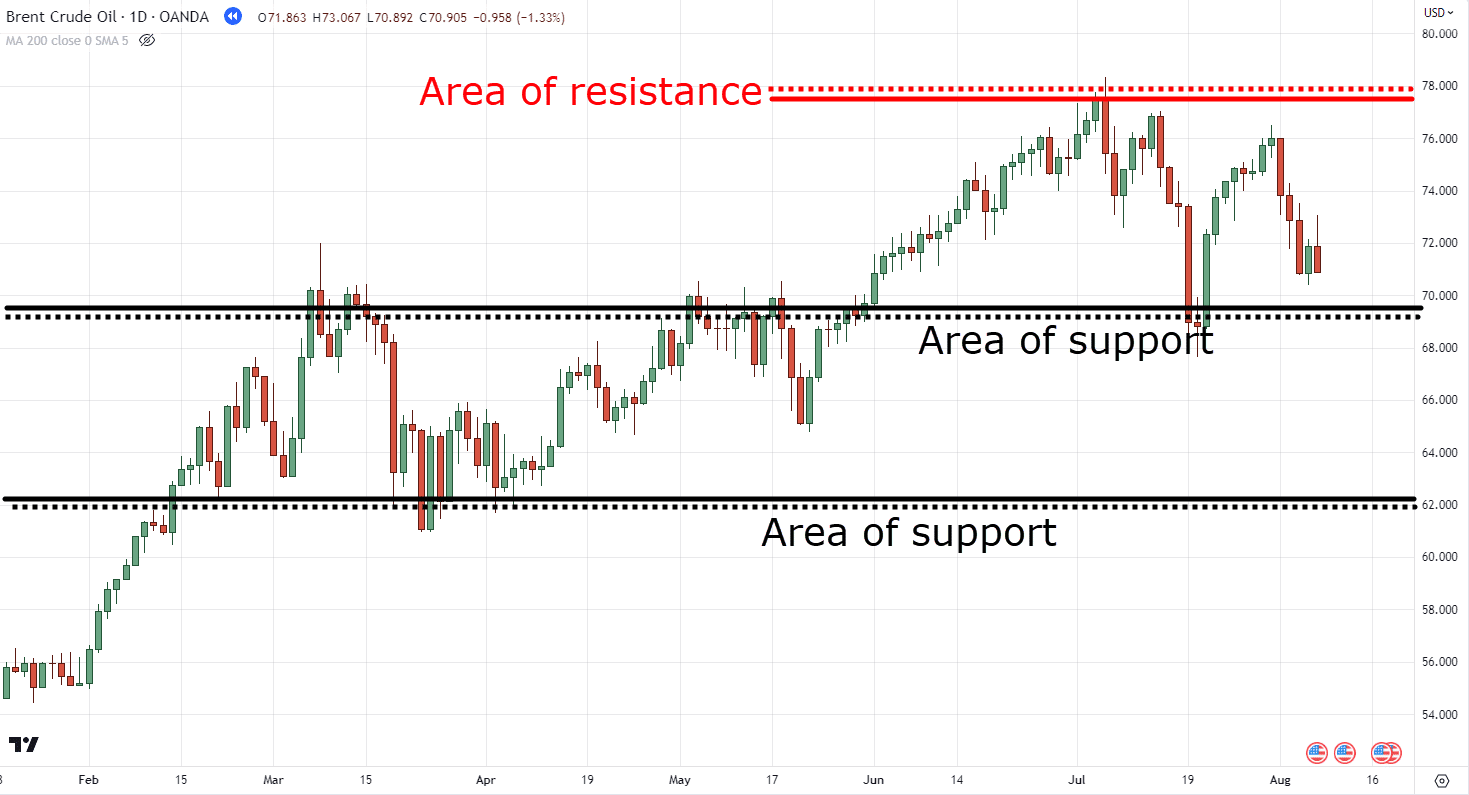
With that said, let’s have a quick check of what we have here.
Long-term uptrend?
Check.
Medium-term range?
Check.
Area of value plotted?
Check.
So, where do you place your orders now?
Simple, just follow this formula:
- Long-term uptrend + medium-term range = Limit order at support (long)
- Long-term downtrend + medium-term range = Limit order at resistance (short)
With that formula mentioned…
Which one should you pick based on Brent Crude Oil?
Correct.
Formula A!

Why formula A?
Well, it’s because we want to hop into the long-term uptrend on a bargain!
Similarly…
If you are shorting the markets…
Then you want to hop into the long-term downtrend at a favorable price before it crashes back down lower!
Makes sense?
Now that you have your limit order in place, what’s next?
You wait until the price hits your limit order!
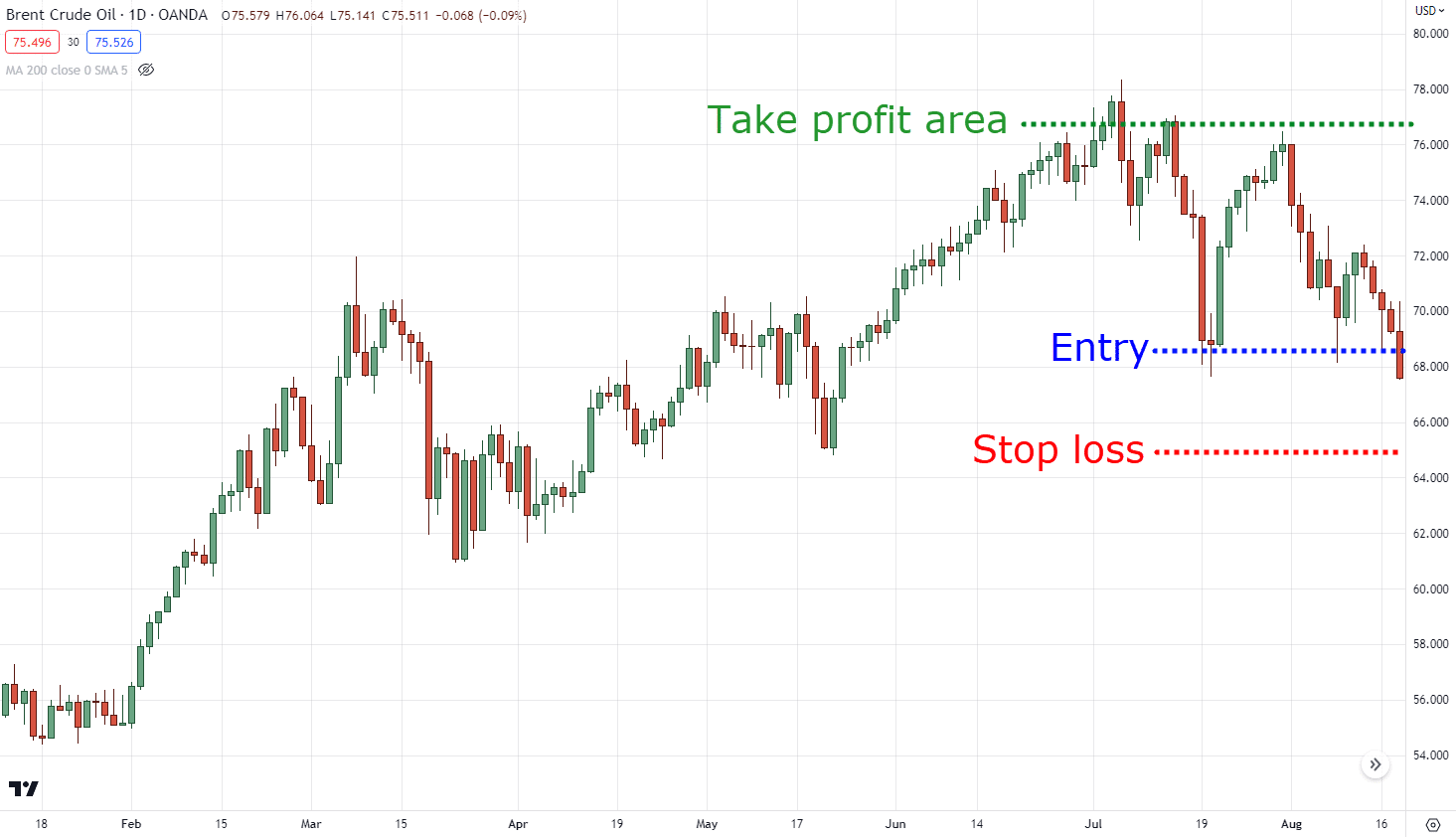
And you’re in, baby!
But not only that.
You’re in a favorable trade with a good risk-to-reward!
But we’re not done yet!
Step 3: Manage the trade accordingly
Now, it’s time to manage the trade accordingly.
If you placed a limit order at support in a ranging market…
It’s best to exit before resistance as shown in the previous example.
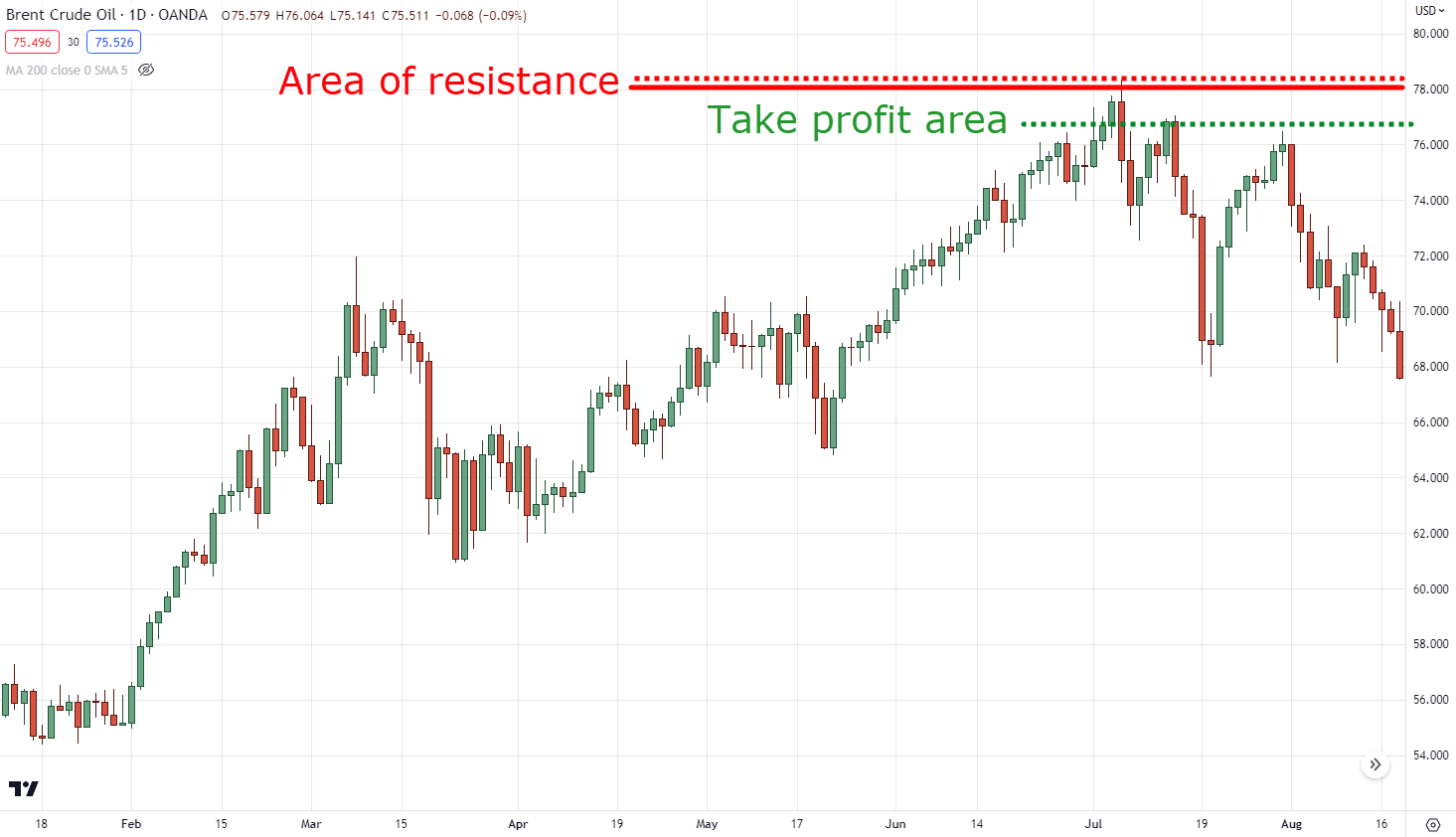
Why before resistance?
Because areas of value are where buyers and sellers are fighting each other out!
Sure, it can be good when making trading decisions before placing a limit order.
But you want to make sure you avoid it when you’re in the trade!
Now…
If you’re someone who doesn’t want to take too much risk, then taking profits before the next area of value is a valid move to make!
You’re done!
Time to look for the next trade!
But what if I told you…
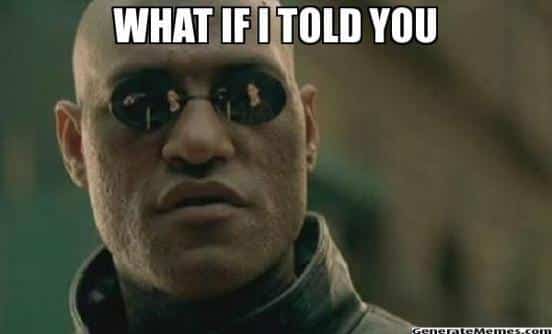
That there’s a way to maximize your grains?
Bonus: Partial take profit before resistance, then place a stop order above breakout to trail stop loss
Still here?
Great!
Because if you want to take things to the next level, then here are three bonus tips for you…
- Once your trade hits your first target profit, only take 50% of your profits
- Once you’ve taken partial take profits, place a stop order at the breakout
- Trail your stop loss using a medium-term moving average
Ready to reach the climax of this trading guide?
Then keep reading!
Once your trade hits your first target profit, only take 50% of your profits
Remember our limit order setup where you entered the lows of a range while the long-term trend is intact?

Great!
Because if you decide to stay in the trade and anticipate the continuation of the long-term trend…
Then you can take half of your open profits.
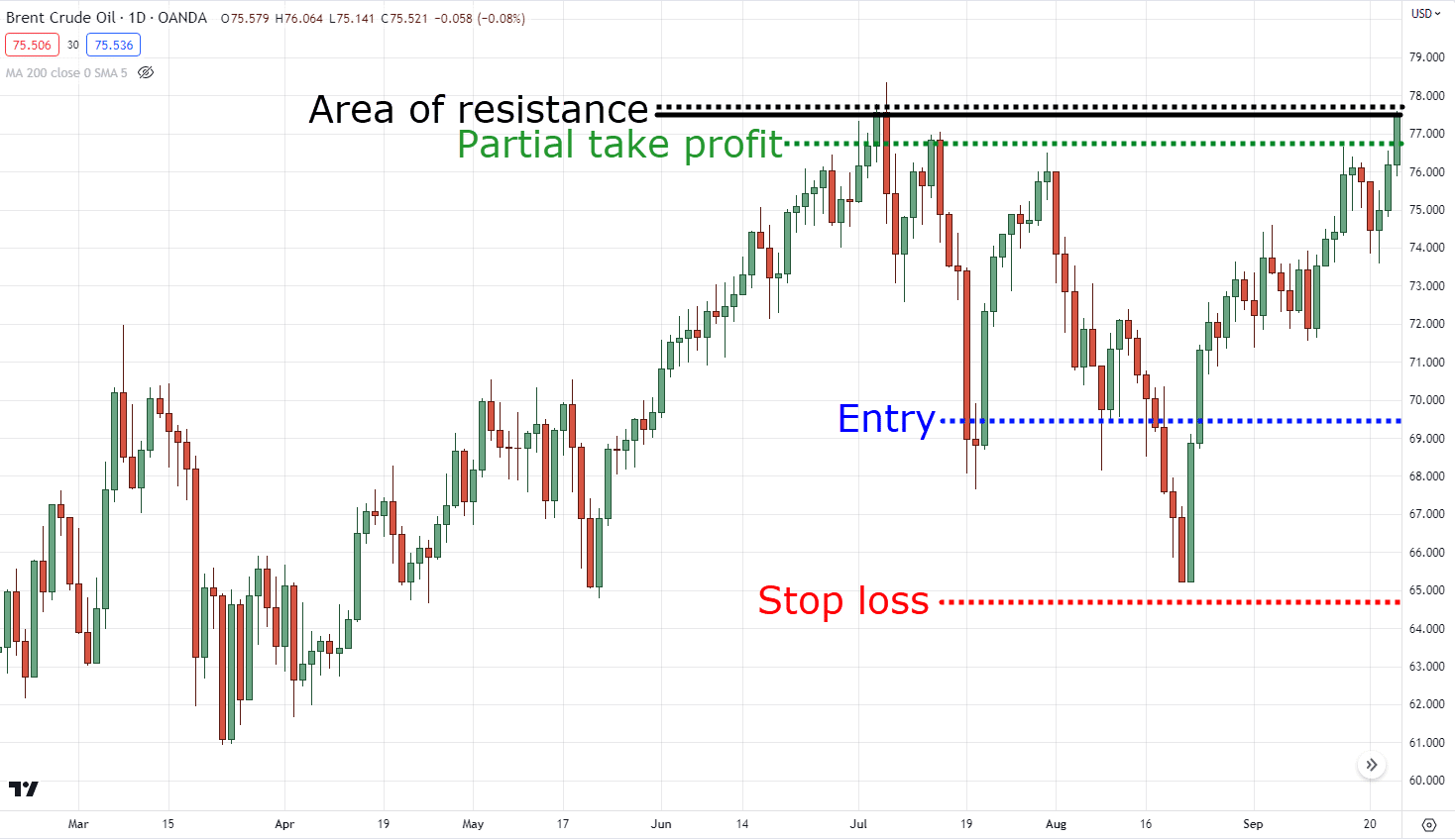
Why would you do this?
Well, doing this would put you in a better psychological state as you can be more comfortable riding the trade longer since you’ve already taken partial profits.
That makes sense, right?
Once you’ve partially taken profits, place a stop order at the breakout
Here’s the truth…
We can never guarantee breakouts in the markets.
This is why I mentioned the word “anticipate” earlier, remember?
And since we cannot guarantee breakouts what do we do?
That’s right.
We only set a stop order.
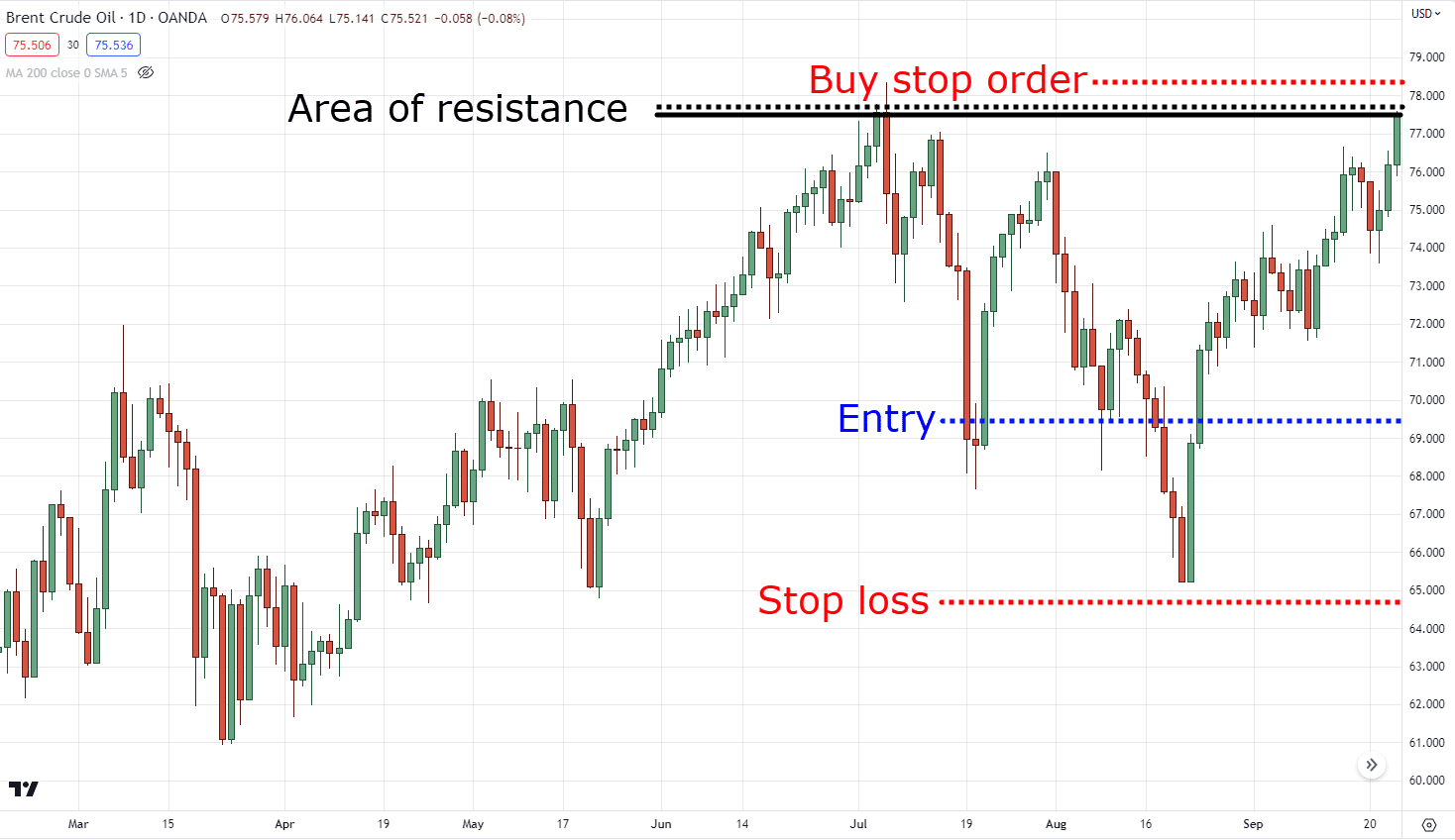
This means that you don’t do anything until an actual breakout is confirmed.
Because let’s face it…
False breakouts do happen!
That my friend, is how to trade what you see.
Not what you think!
This is why if the market does break out and hits your stop order…
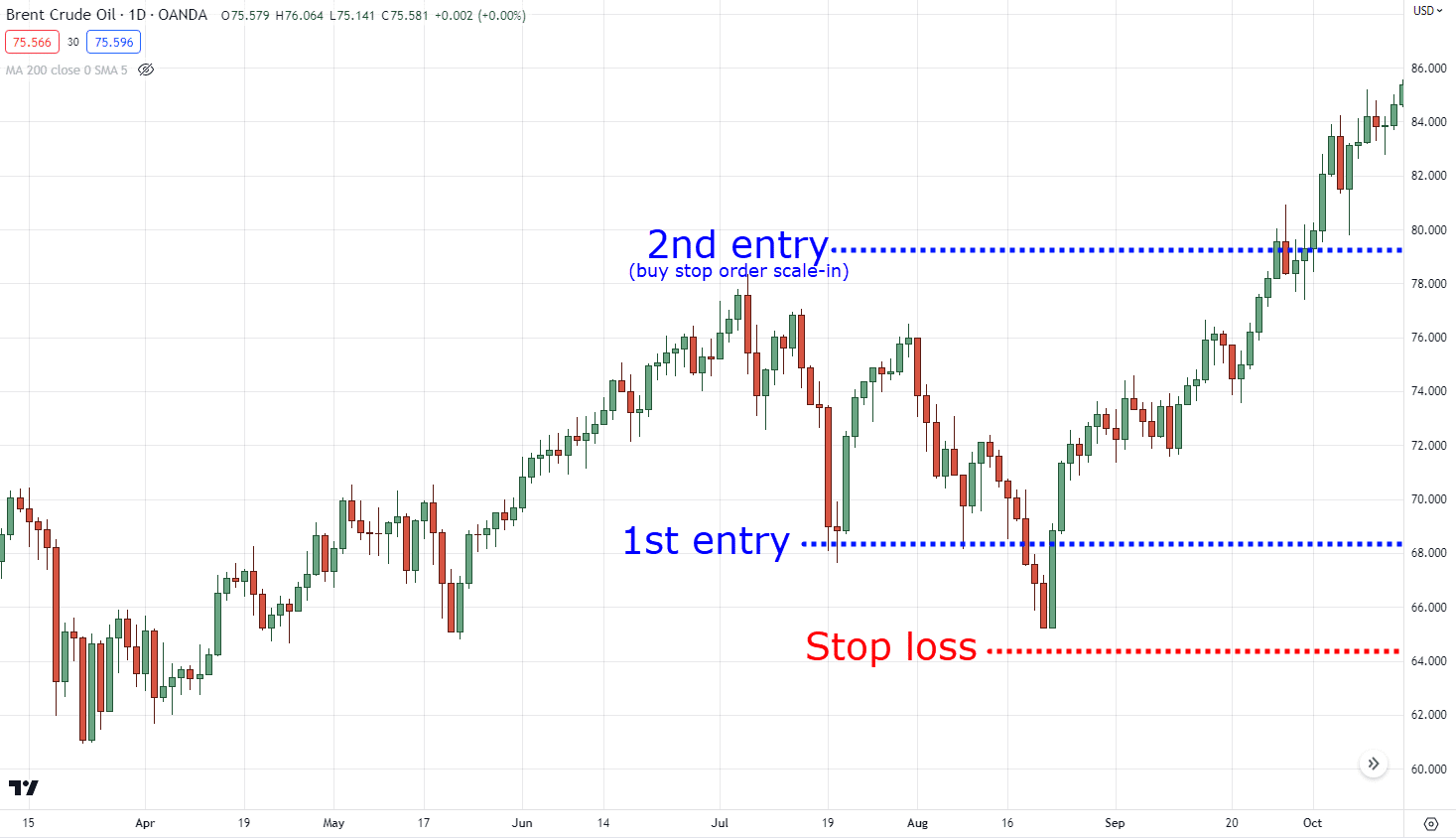
Then it’s a clear sign that the long-term trend is about to resume.
So, you scale into your trade once again!
Lastly, how do you manage your trade this time around?
Here’s a tested and proven solution…
Trail your stop loss using a medium-term moving average
Remember the 200-period moving average to objectively define trends?
Great!
Now just lower that period to a 50-period moving average so that you’d only exit your trade if it closes beyond it:
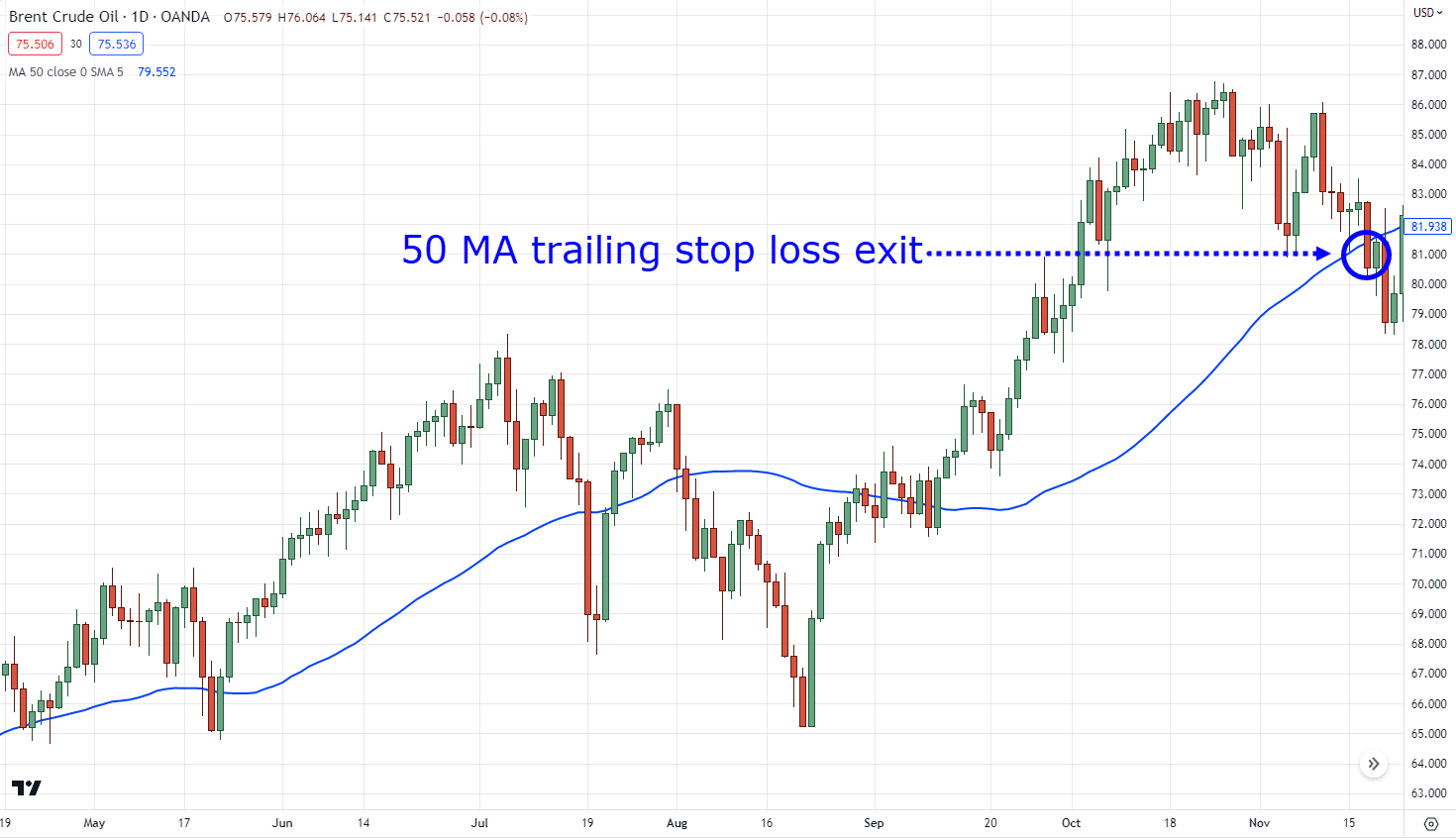
Pretty amazing, right?
With these extra steps, you can both minimize risk and increase your rewards!
Now as promised…
Here are a couple more examples of what I’ve taught you today.
BTCUSD Daily timeframe:
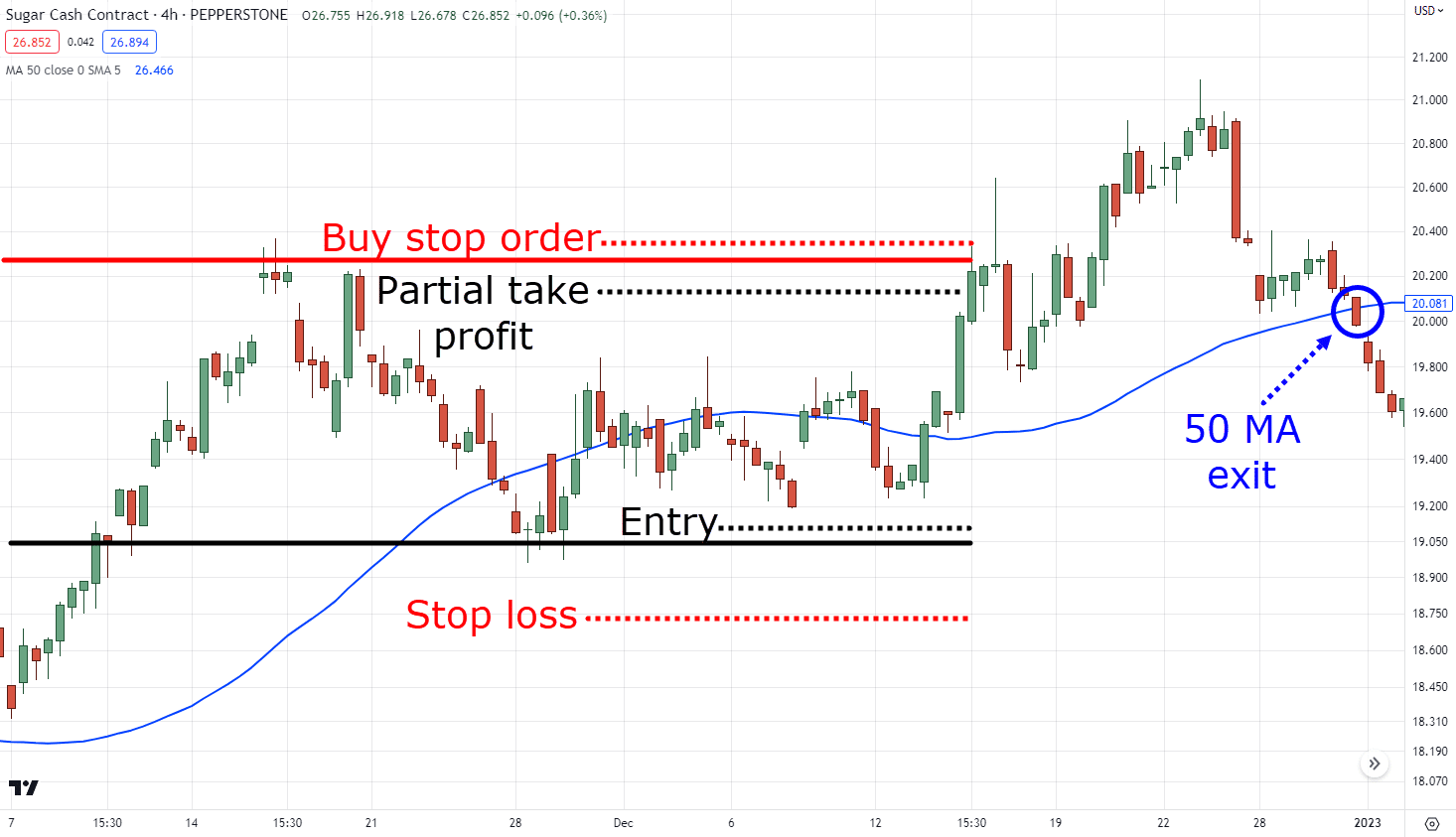
EURUSD 4-hour timeframe:
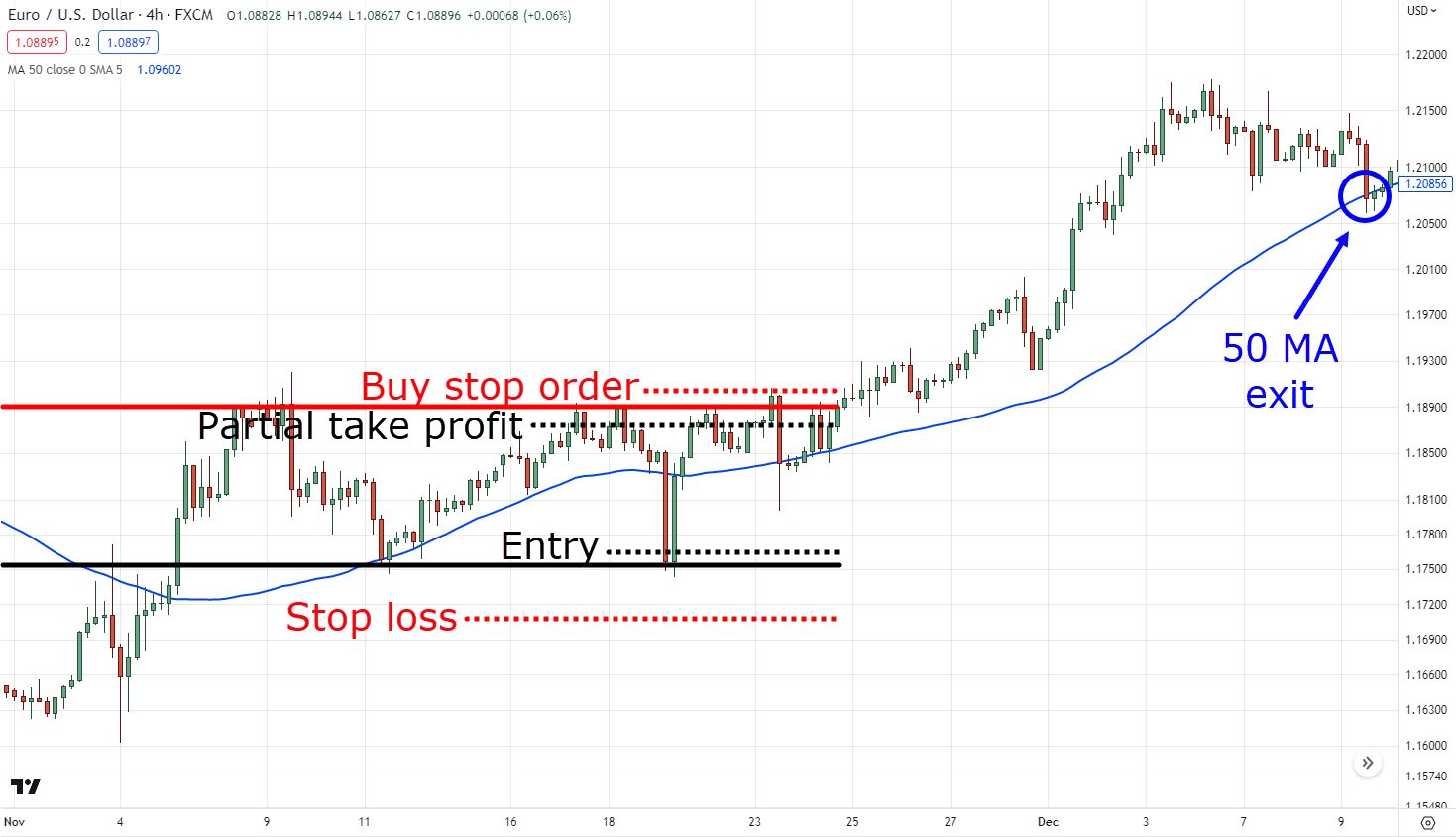
Sugar 4-hour timeframe:

There you have it!
The secret to using both orders!
So, before I end this guide…
Remember to always identify the market condition, place the appropriate orders, and manage the trade accordingly!
Limit order vs stop order: Which one is the best and which one should you use?
Sure…
I may have shared with you how to use a limit order and a stop order along with price action.
But the truth is that you can use both types of orders across different trading styles!
And that can overwhelm you!
I feel obligated to make sure I give you the “perspective” needed to use these orders.
So…
If you’re a pullback or range trader, you’ll want to use a limit order
There are many trading styles where a limit order can be suited.
That can be trading styles such as:
- Harmonic pattern trading
- Elliot wave trading
- Mean reversion trading
To complement those styles with a limit order, you can consider using tools like the Fibonacci retracement.
On the other hand…
If you’re a breakout or trend trader, you’ll want to use a stop order
Once again, trading styles where using a stop order can be useful with:
- Momentum trading
- Trend following
And finally, you can use a wide variety of tools such as moving averages and the Donchian channel to help you out.
In general!
Use a limit order for pullbacks and ranges, and use a stop order for breakouts and trends.
Most of all…
Make sure to always do your due diligence by testing concepts yourself before risking money!
Conclusion
There you have it!
Everything you need to know about limit order vs stop order (and more).
By using them appropriately and in the right market conditions, you’ll be able to take your trading game to the next level!
So, here’s a quick recap of what you’ve learned for today’s trading guide:
- A limit order is a type of order you place below the price to time pullbacks, while a stop order is a type of order you place above the price to time breakouts in the market
- Never place a limit order above the price or place a stop order below the price, furthermore, always place your orders in areas of value
- You can use both limit and stop orders by timing pullbacks and breakouts
- The effectiveness of a limit or stop orders depend on how well it complements a certain trading style
Congratulations!
You’ve come to the end of this guide!
So, this time…
I want to hear your thoughts.
Do you use a limit or stop orders?
Or do you prefer to enter markets manually at their current price?
Let me know in the comments below!


